One of the best things to do in Yogyakarta is to visit the two most famous temples that are located just outside the city. We’re sharing exactly what to expect when you visit both Borobudur Temple and Prambanan Temple as well as some insider tips!
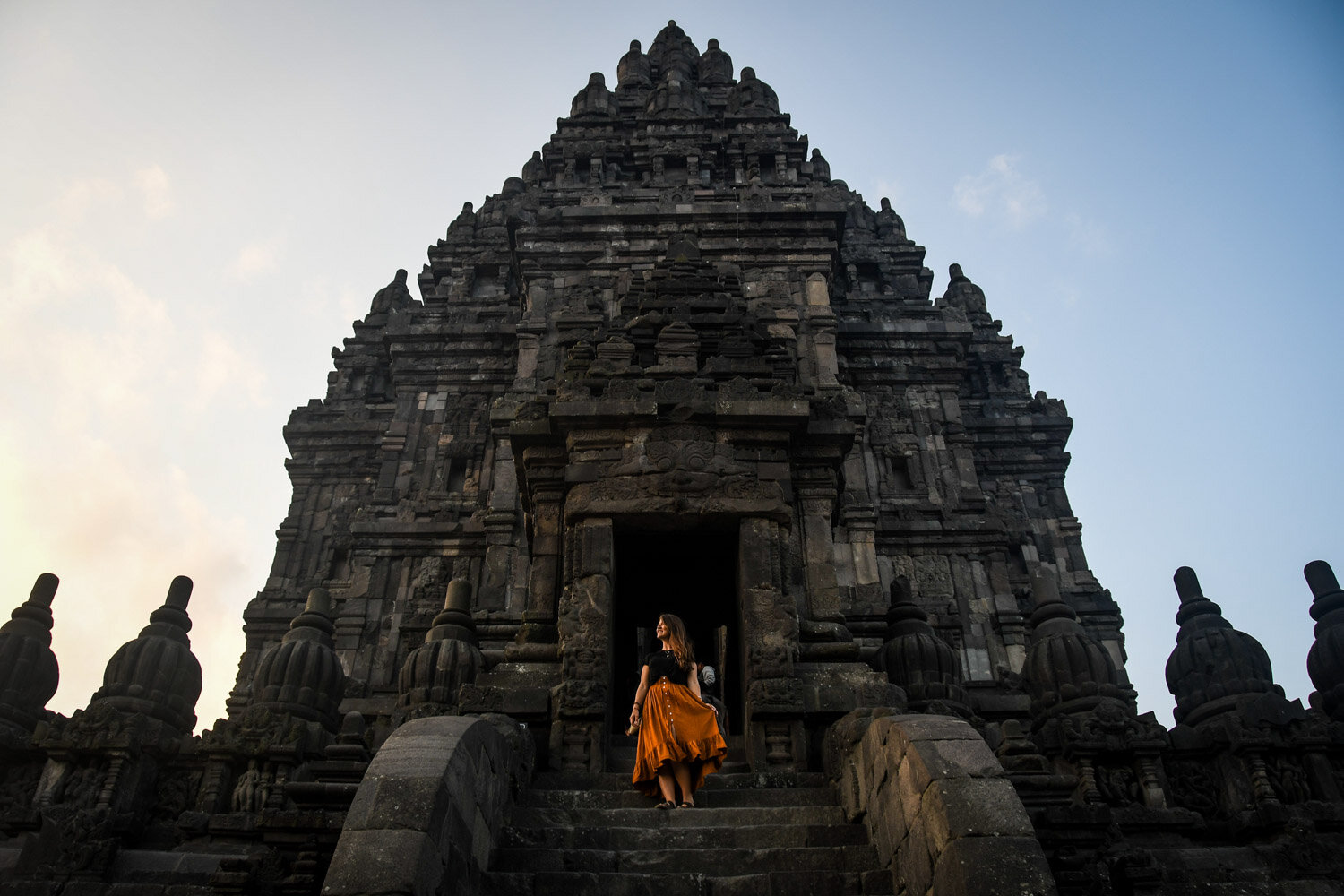
Yogyakarta is a city known for food, culture, and history. And while there’s plenty of things to do in Yogyakarta itself, perhaps the most famous attractions lie just a short drive from the city center: the iconic temples of Borobudur and Prambanan.
If you’re planning a trip to Yogyakarta, you’ll soon realize that seeing both of these temples are a must. They are quite different from one another, so visiting each is both totally doable (even with a short amount of time) and worthwhile. Plus, they are both UNESCO World Heritage Sites, and hold a significant amount of importance and history.
One interesting thing that we should point out is Borobudur is a Buddhist temple and Prambanan is Hindu, but the vast majority of people living on the Island of Java today (and Indonesia in general) are Muslim.
What to expect… The iconic Borobudur Temple is both the largest Buddhist structure in the world and the most-visited tourist attraction in Indonesia. That is hard to compete with, but Prambanan Temple is a spectacular sight as well, often compared to Cambodia’s famous Angkor Wat.
In this article, we’re walking you through everything you need to know about Yogyakarta’s two most famous temples: Borobudur and Prambanan.
We’re sharing how to get there, what to wear, the best time of day to visit, fun facts, and our top insider tips to ensure you have the best possible time.
Article Contents
This article is split into three sections, one for each temple (as well as a section for those interested in visiting both temples):
Borobudur Temple Guide
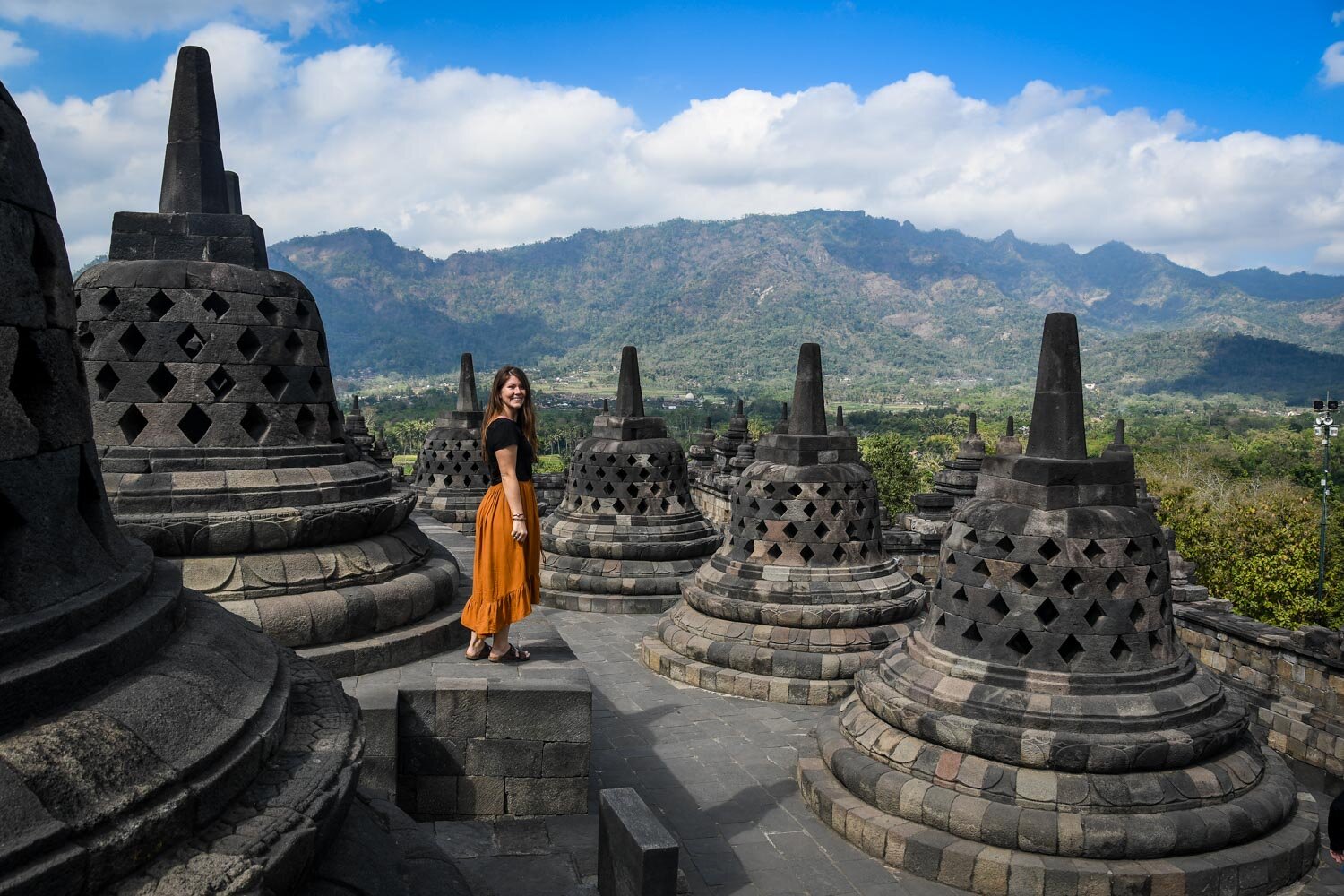
These bell-shaped pagodas grace Instagram feeds and guidebooks, and paired with pinkish skies and misty hills and views of Mount Merapi in the distance, this place looks like something out of a dream.
Borobudur is the largest Buddhist temple in the world, and on top of its size, it is a truly magnificent sight. There’s no wonder why this is the single most visited tourist attraction in Indonesia.
Borobudur Temple Basic Info
-
Buddhist Temple
-
UNESCO World Heritage Site
-
Visiting Hours: every day from 6 a.m. to 5 p.m.
-
To see sunrise at Borobudur, you can get a special ticket that allows you to enter at 4:30 a.m. (more info on that below).
-
-
Toilets: There are clean restrooms near the entrance. There was toilet paper when we were there; but while traveling in Java, we always carried some (just in case) in our backpack.
-
Crowds: Borobudur is most crowded on weekends. Sunrise tends to be a very popular time to visit as well as mid-morning through mid-afternoon when large tour buses arrive. There are windows from 6 a.m. to 9 a.m. and later in the afternoon when the crowds tend to be less.
-
Guide: It is possible to hire an English speaking guide on site, or book a tour that includes transportation.
Borobudur Temple Entrance Fee
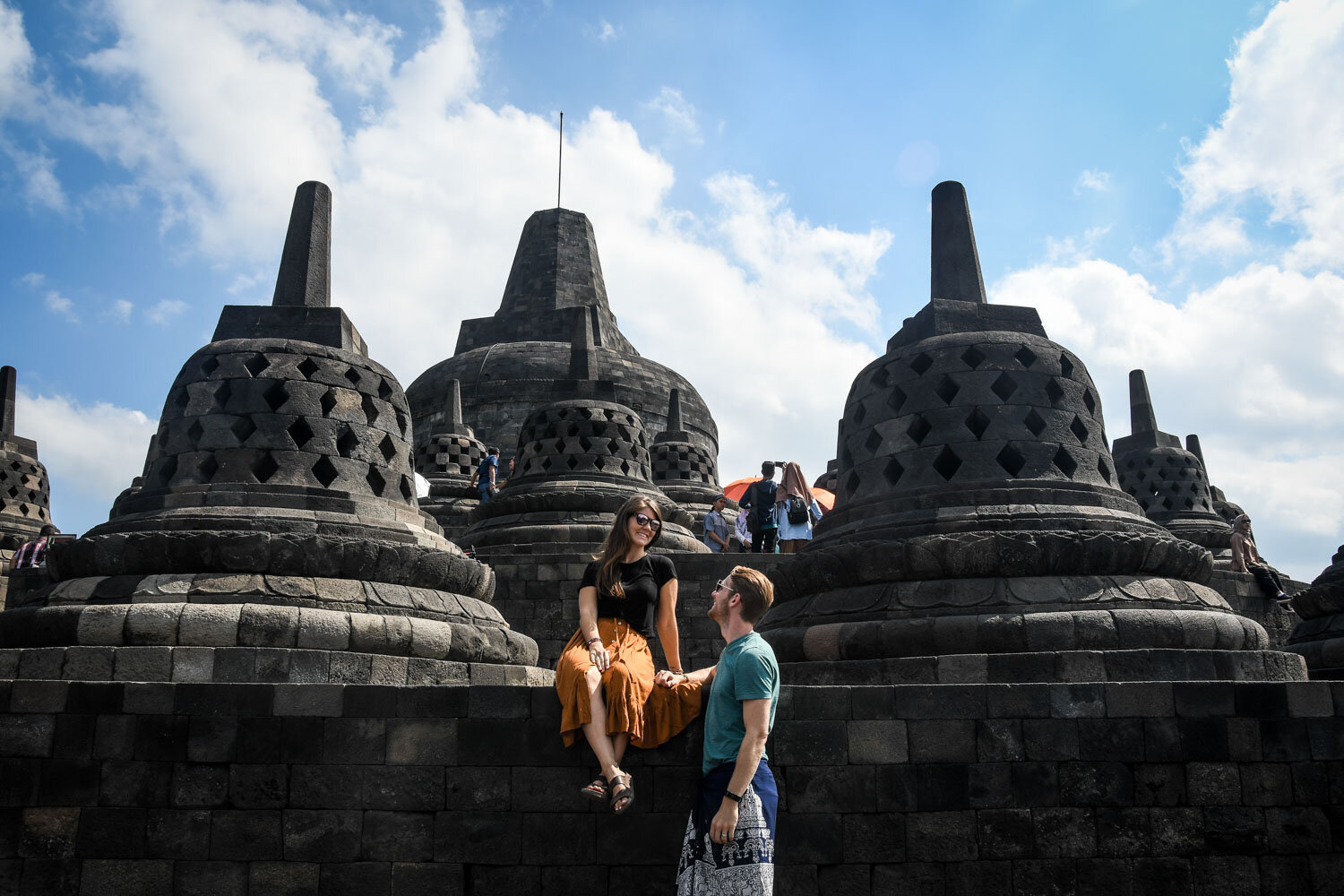
See below for all ticket prices (as of April 2020). Ticket prices seem to increase each year, so keep this in mind as you plan your trip.
Important Note: Below are the prices for REGULAR tickets. We have more information later in this article on Sunrise and Sunset Tickets (which are more expensive) as well as the Borobudur + Prambanan Combo Discount Ticket.
Adult
-
Foreign Visitor: $25 USD (390,000 IDR)
-
Domestic Visitor: $3.50 USD (55,000 IDR)
Student (must show your valid student ID)
-
Foreign Student: $15 USD (230,000 IDR)
-
Domestic Student: $1.75 USD (27,000 IDR)
Are you a student? Bring your student ID and get an additional 40% off the total ticket price. That’s a savings of $10 USD!
Child (6 – 10 years old)
-
Foreign Child: $15 USD (230,000 IDR)
-
Domestic Child: $1.75 USD (27,000 IDR)
Good to know: You can pay with credit card or cash (Indonesian rupiah). The price in USD is set, but the amount in IDR can fluctuate depending on the current conversion rate.
Quick History & Interesting Facts about Borobudur Temple
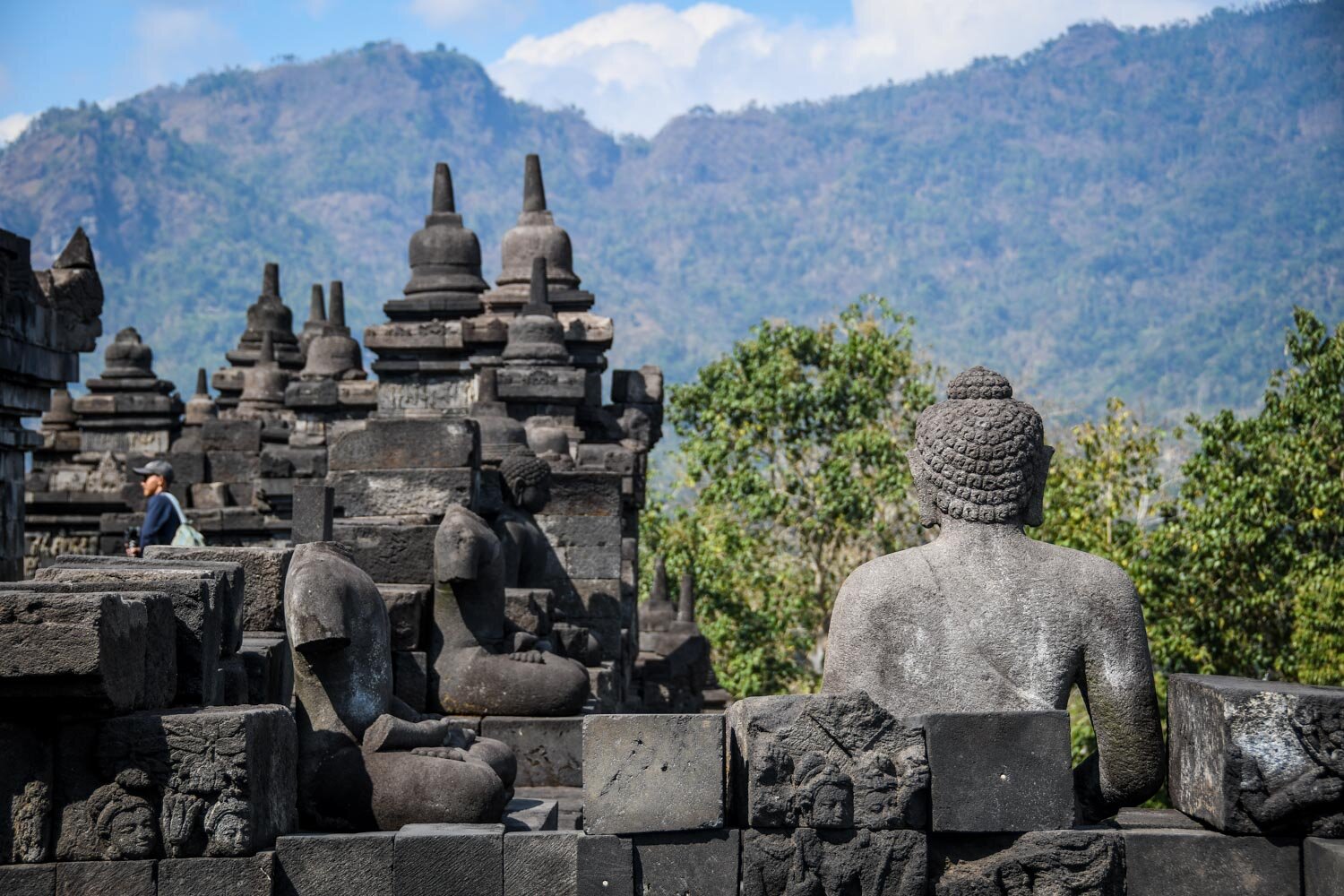
-
Borobudur is the world’s largest Buddhist temple. This temple was built as a shrine to Lord Buddha and is a Buddhist pilgrimage site.
-
Historians believe that Borobudur was constructed in the 9th century, and evidence suggests that it was later abandoned when Islam was introduced to Java, pushing other other religions out.
-
Borobudur was built without any cement or mortar to hold the pieces together. Instead, builders used interlocking techniques to fit the blocks into place.
-
After being abandoned, Borobudur lay hidden beneath jungle and layers of volcanic ash for centuries. It was “rediscovered” in the early 1800’s when the British ruler of Java heard of its existence.
-
The original temple had a mind-boggling 504 Buddha statues. Today, 300 of those are damaged in some way (usually missing the head), and 43 are missing. Some of the heads of the Buddha statues are on display in museums around the world, like The British Museum in London.
-
On the top (most iconic) level of Borobudur, there are 72 Buddha statues inside bell-shaped stupas. If you get close to them and look through the holes, you can see the Buddha. If you look closely, you’ll notice that while they appear similar, they have a variety of different mudras (positioning of the hands).
-
One really impressive aspect about the construction of Borobudur is that it was built with volcanic stone that was laid without using any mortar. The structures stay in place because of how precisely the stone was cut, as well as with the help of gravity.
Planning a trip to Java? We’ve gathered up all the best things to do in Java, plus insider tips and a perfect 1-week itinerary to hit all the highlights (including these temples of course!)
Best time to visit Borobudur
-
Visiting Hours: every day from 6 a.m. to 5 p.m.
-
To see sunrise at Borobudur, you can get a special ticket that allows you to enter at 4:30 a.m. (more info on that below).
-
Morning (with a caveat)
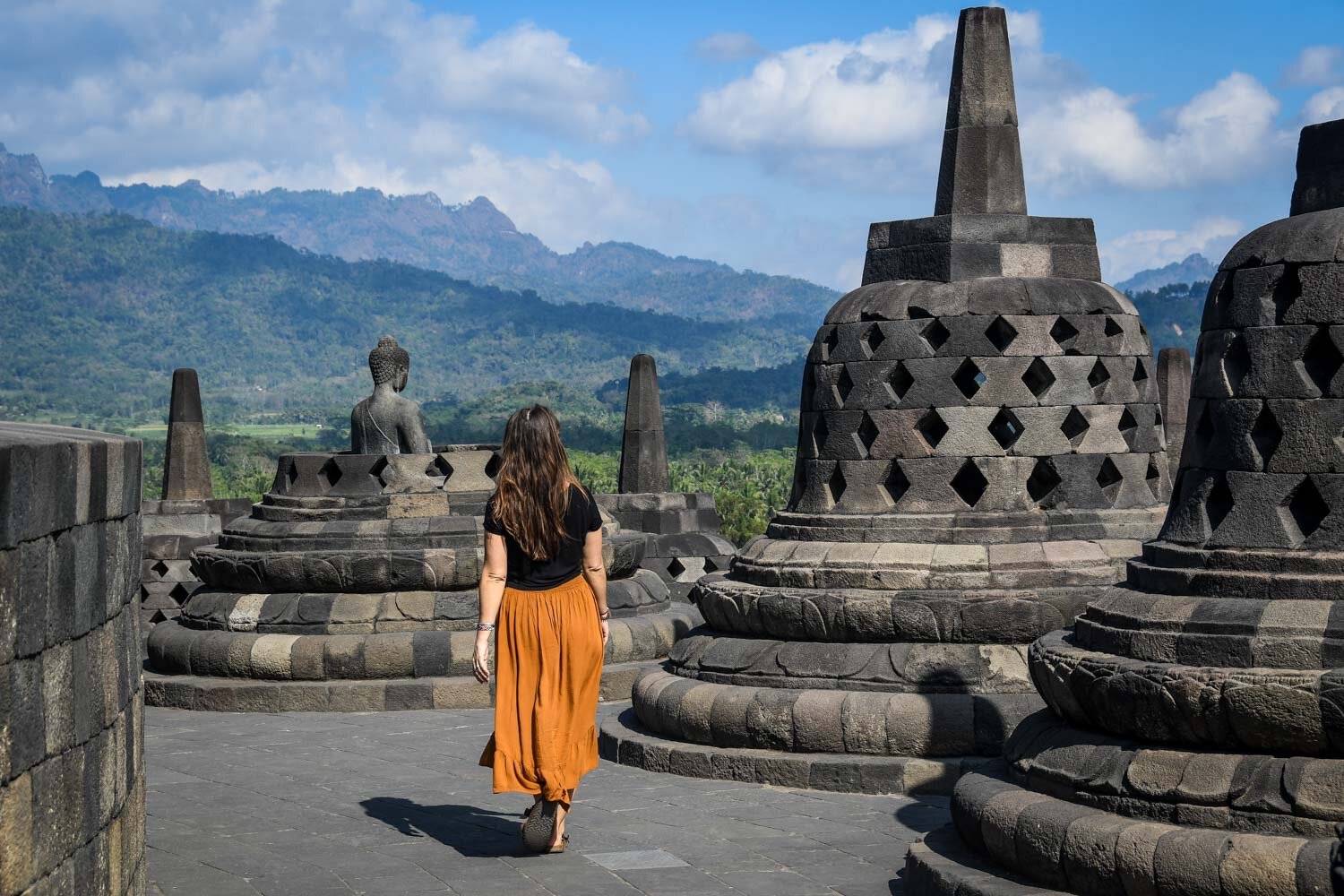
The most famous pictures of Borobudur are taken at sunrise, and it looks undeniably beautiful. If you are a photographer, you may want to consider getting an early start and making it for first light.
While many websites might exclusively recommend getting to Borobudur at sunrise, we’d don’t think it’s necessary to be there at sunrise for all travelers.
We definitely recommend getting to Borobudur in the morning in a more general sense, but whether sunrise is the best time for you depends on your personal travel style, your feelings on crowds, and your budget.
Borobudur Sunrise
Sunrise at Borobudur looks spectacular (just take a look at the photos below!), and if it fits into your schedule, by all means DO IT! However, there are a few drawbacks to getting there at the crack of dawn that you should take into consideration.
We’re rounding up all the facts and explaining why we didn’t go for sunrise.
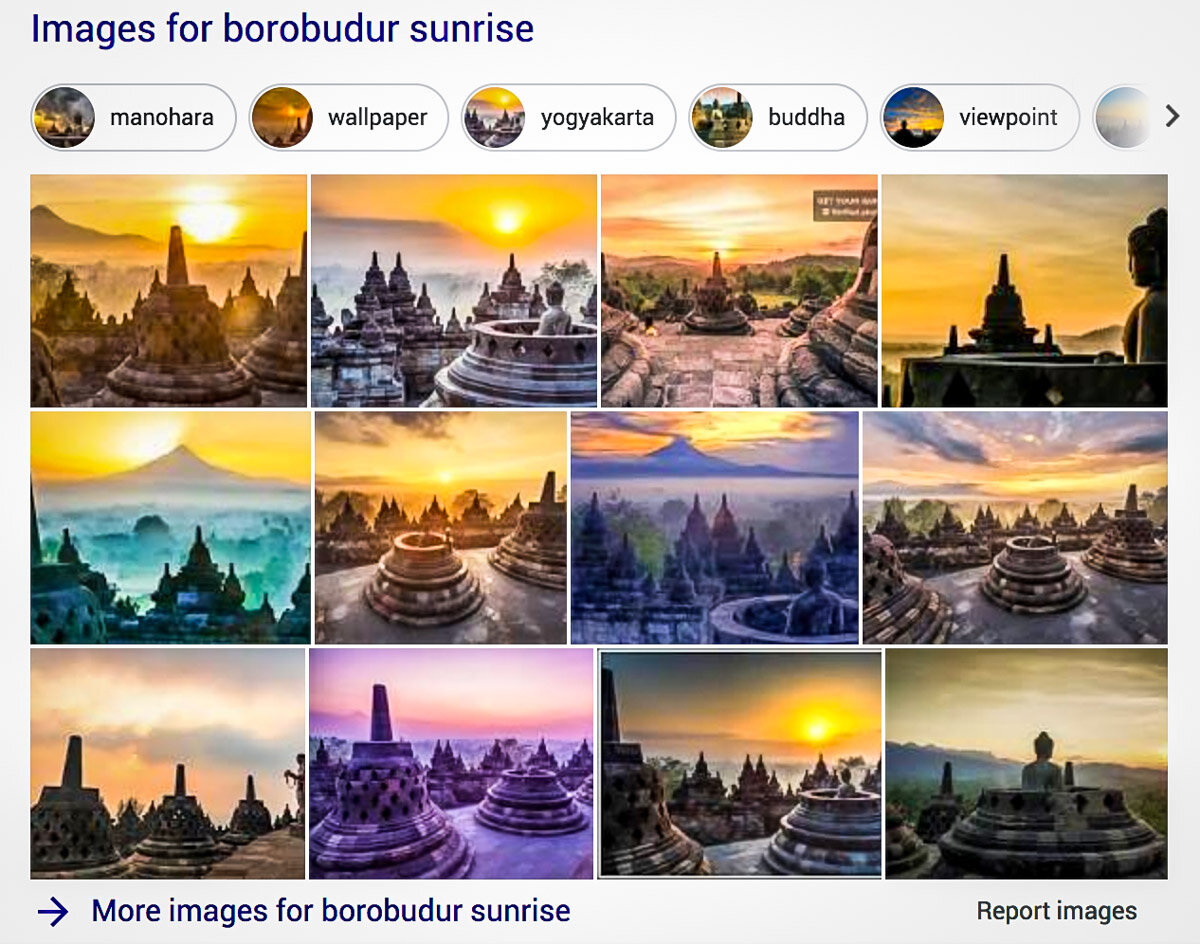
Google Image search results for “Borobudur Temple Sunrise”. How beautiful are these shots?!
Sunrise at Borobudur Temple: What you need to know
-
You must purchase your ticket through the Manohara Hotel. It is located very close to the temple and is the only place that can sell sunrise tickets. (There are some Borobudur Sunrise Tours on Get Your Guide in which your guide will get tickets through the Manohara Hotel.)
-
Good to know: You do not need to be a guest of the hotel to purchase sunrise tickets through them.
-
-
It’s more expensive. A regular entry ticket to Borobudur costs $25 USD (adult foreign visitor ticket), while a sunrise ticket costs $35 USD (500,000). That’s an extra $10 USD, which in the scheme of things isn’t too bad (plus, it includes breakfast). So if visiting at sunrise is a dream of yours don’t let the cost deter you. However, if you’re traveling on a tight budget, this might be more than you’d like to spend.
-
You won’t avoid the crowds. In fact, this is a very popular time to visit Borobudur, and chances are, there will be many professional photographers and Instagrammers all over trying to get their shots. And maybe that’s you – cool! – but if that’s not your jam, you might want to arrive a tad later.
-
You’ll have to wake up very early to get there in time. Take into consideration how many “sunrise days” you have planned on your trip to Java. (If you plan to visit Mount Bromo and Ijen Crater, that’s two sunrise wake-ups right there.) Some people live for sunrises, while others will get burned out quickly. You know yourself and are the only one that can determine what’s the right move for you.
-
If you are staying in Yogyakarta, you’ll need to leave the city around 3:30 a.m.
-
If you are staying near Borobudur, you’ll need to leave your hotel around 4:30 a.m.
-
-
Depending on what time of year you’re traveling to Indonesia, paying extra for the “sunrise ticket” may not be worthwhile. For example, throughout much of November, the sun rises at 5:10 a.m., which means those who have paid for the sunrise entrance of Borobudur will get quite the show before those with “normal tickets” are allowed inside the complex. If, however, you’re traveling in July when the sun rises just after 5:50 a.m., you have less than 10 minutes before doors open to the public. So that extra cash isn’t really worthwhile.
-
Tip: Look up the time of sunrise on the date of your intended visit to help you decide. (This is a good resource for finding sunrise/sunset times.)
-
Borobudur Sunrise Ticket Price
As we explained, the only place you can purchase tickets to visit Borobudur Temple before sunrise is at the Manohara Hotel.
You can show up and purchase your ticket on the spot. Be sure to get there around 4 a.m. in order to be ready on time.
You can pay in cash (IDR) or with a credit card. Prices in USD are fixed, but the amount in rupiah will fluctuate depending on the current exchange rate. (These prices were updated in April 2020.)
Adult Price
-
Foreigner Visitor: $35 USD (IDR 500,000) 555k IDR
-
Domestic Visitor: $26 USD (IDR 370,000) 415k IDR
Student Price
-
Foreigner Visitor: $28 USD (IDR 400,000) 445k IDR
-
Domestic Visitor: $20 USD (IDR 280,000) 320k IDR
Child Price (6 to 10 years old)
-
Foreigner Visitor: $18 USD (IDR 250,000) 285k IDR
-
Domestic Visitor: $13 USD (IDR 185,000) 205k IDR
*Children under 6 years old free of charge
Good to know: You cannot do the discounted Borobudur + Prambanan Combo Ticket if you want to visit at sunrise.
What does this ticket price include?
Sunrise Ticket:
-
Early entrance to Borobudur Temple starting at 4:30 a.m.
-
you will be given a flashlight you can borrow for your 5-minute walk to the temple
-
Borobudur opens to the general public at 6:00 a.m., so only those with sunrise tickets will be there before the gates open.
-
-
Breakfast & tea/coffee & light snack
-
Souvenir sarong
OR
Sunset Ticket:
-
You can stay at the temple until 6:30 p.m.
-
General ticket holders will be asked to leave before 5 p.m.
-
-
Dinner
-
Souvenir sarong
Don’t want to get there for sunrise?
If you’re not keen on doing the sunrise tickets, our recommendation would be to still aim to get there as early as possible.
Remember, doors open to the public at 6 a.m., so you could arrive as early as that, or you could aim for around 7 – 7:30 a.m. to avoid the sunrise crowd altogether, but still catch some nice light. We arrived at 8:30 a.m. and the light had just starting getting pretty harsh.
Oh, and the earlier you get there, the less heat you’ll have to deal with.
Our Experience at Borobudur Temple
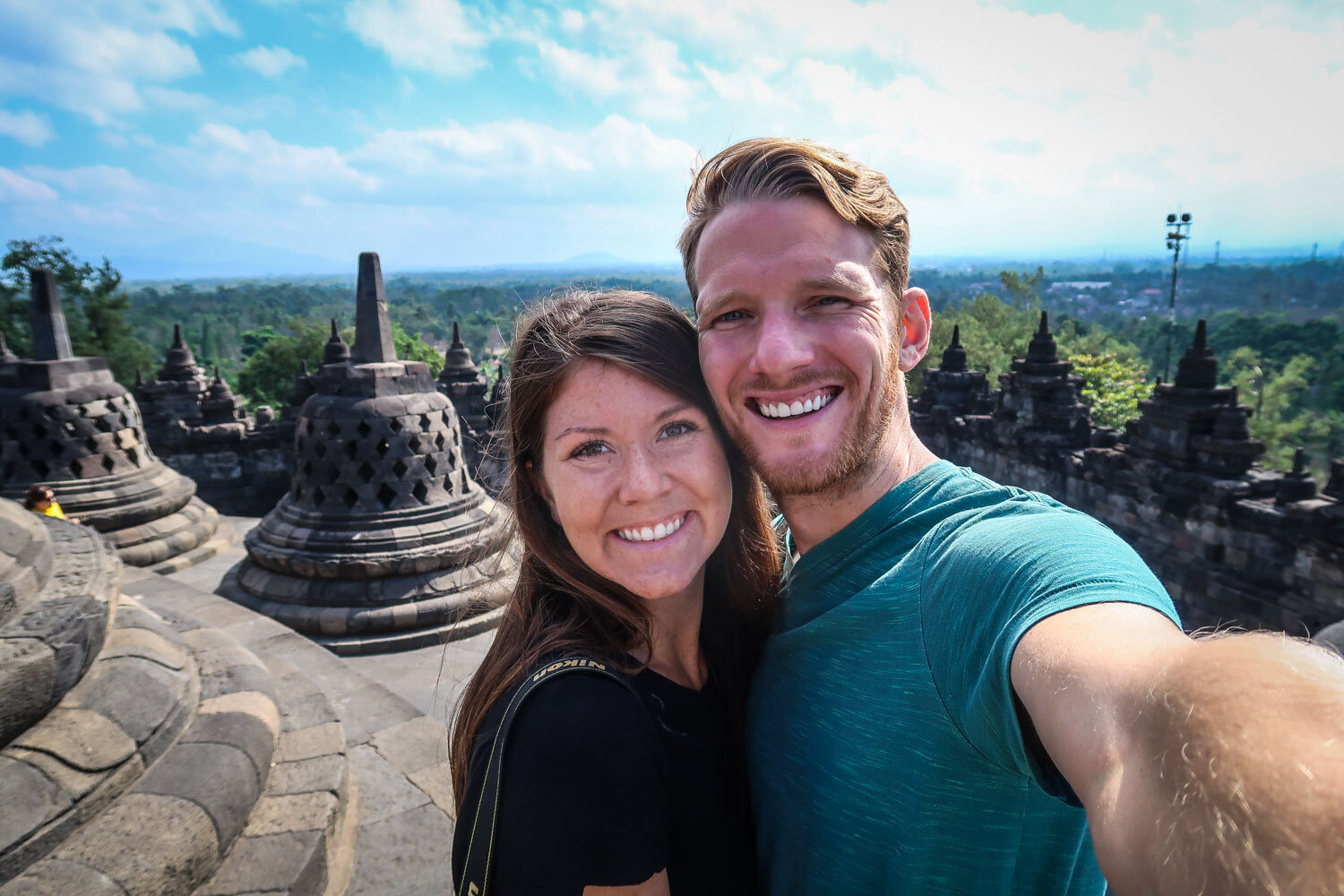
We arrived at Borobudur around 8:30 am, and for us, it felt like alright timing (though an hour earlier would have been even better).
Our goal was to get there at 7 a.m. as the photographer crowd was starting to thin, but in true Katie and Ben fashion, we slept in a bit and didn’t end up leaving until around 6:45 a.m. Also, but we drove ourselves on a motorbike, and it took longer than we had expected (there was a lot of traffic on the way!).
We were just a bit too late to experience the glowy sunrise sky (bummer). The good part about our timing was that we got there after all the professional photographers and Instagrammers had left, but before the large tour buses started to arrive. So for a while, there weren’t a ton of other people.
As some school groups started to arrive, it became a more crowded and we had to wait a bit to get photos without people in them, but it was still possible.
We started getting approached by lots of middle and high school groups asking for photos and lots of students just wanted to practice their English and ask us questions. It was fun at first, but after the 6th group (or 50th… I lost count!), it got a little old. We’ve heard this is pretty common at Borobudur, so just be prepared!
Why didn’t we do sunrise? The main reason was that we already had some early mornings planned for our weeklong trip to Java (Mount Bromo and Ijen Crater both require midnight wake up calls). So we decided to skip the super early wake up call for sunrise at Borobudur. Plus, it saved us a bit of money since we were able to do the discounted combo ticket.
Good to know: It started getting hot – like hot enough I started sweating (which really doesn’t take much, I suppose, but still!) – between 9:30 and 10 a.m., so you’ll want to keep that in mind when planning your visit.
What to wear at Borobudur Temple
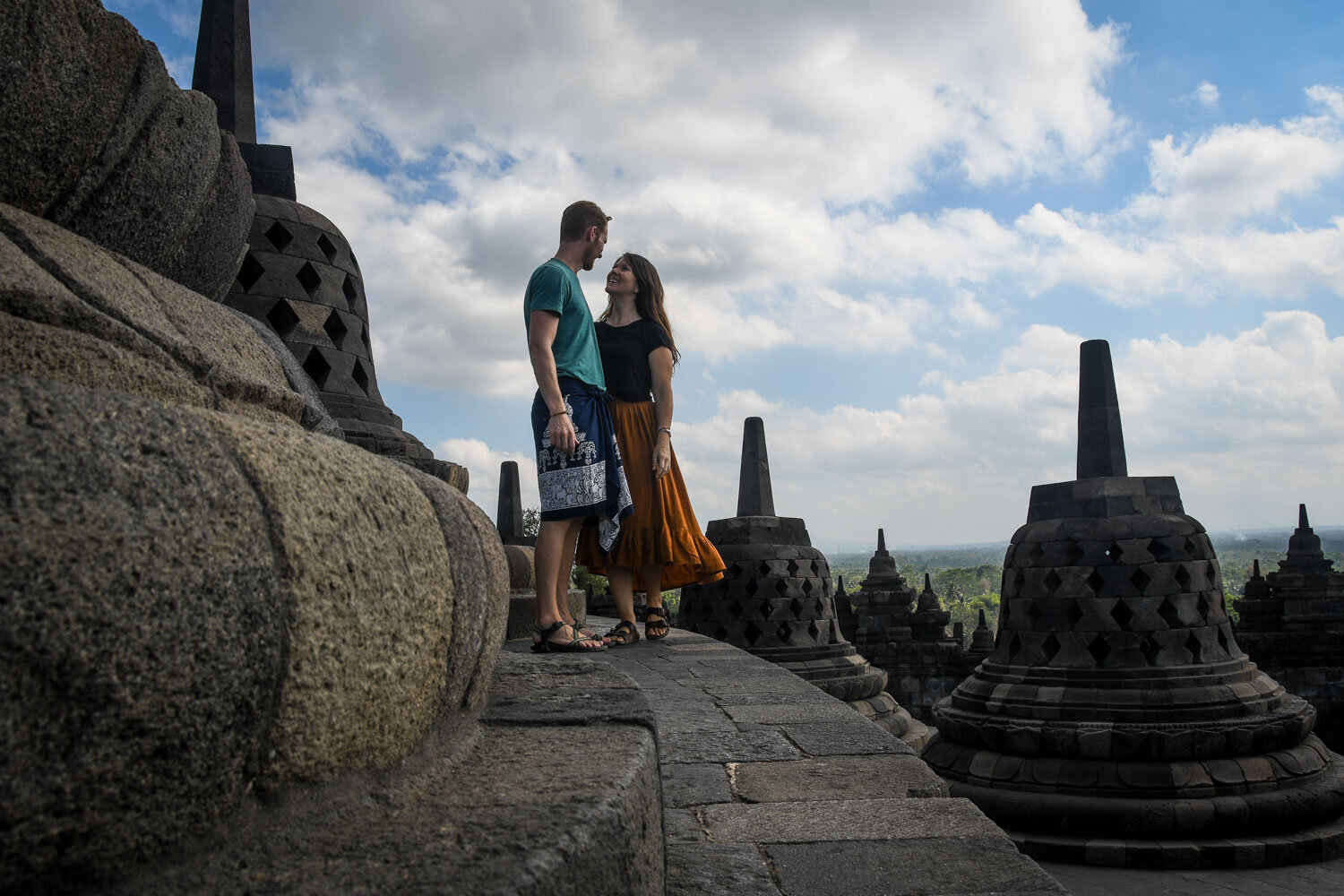
As with any Buddhist temple, it is respectful to cover your knees and shoulders. It’s also a good idea not to wear anything too form-fitting. This is true for men and women.
If you don’t have the correct clothing, you will be given a (surprisingly nice) sarong free of charge to borrow during your visit. Ben’s shorts showed a little too much of his sexy pale knees, so he was given a sarong with which he could cover up. I, on the other hand, was prepared with a long skirt and a t-shirt.
Insider Tips for Visiting Borobudur Temple
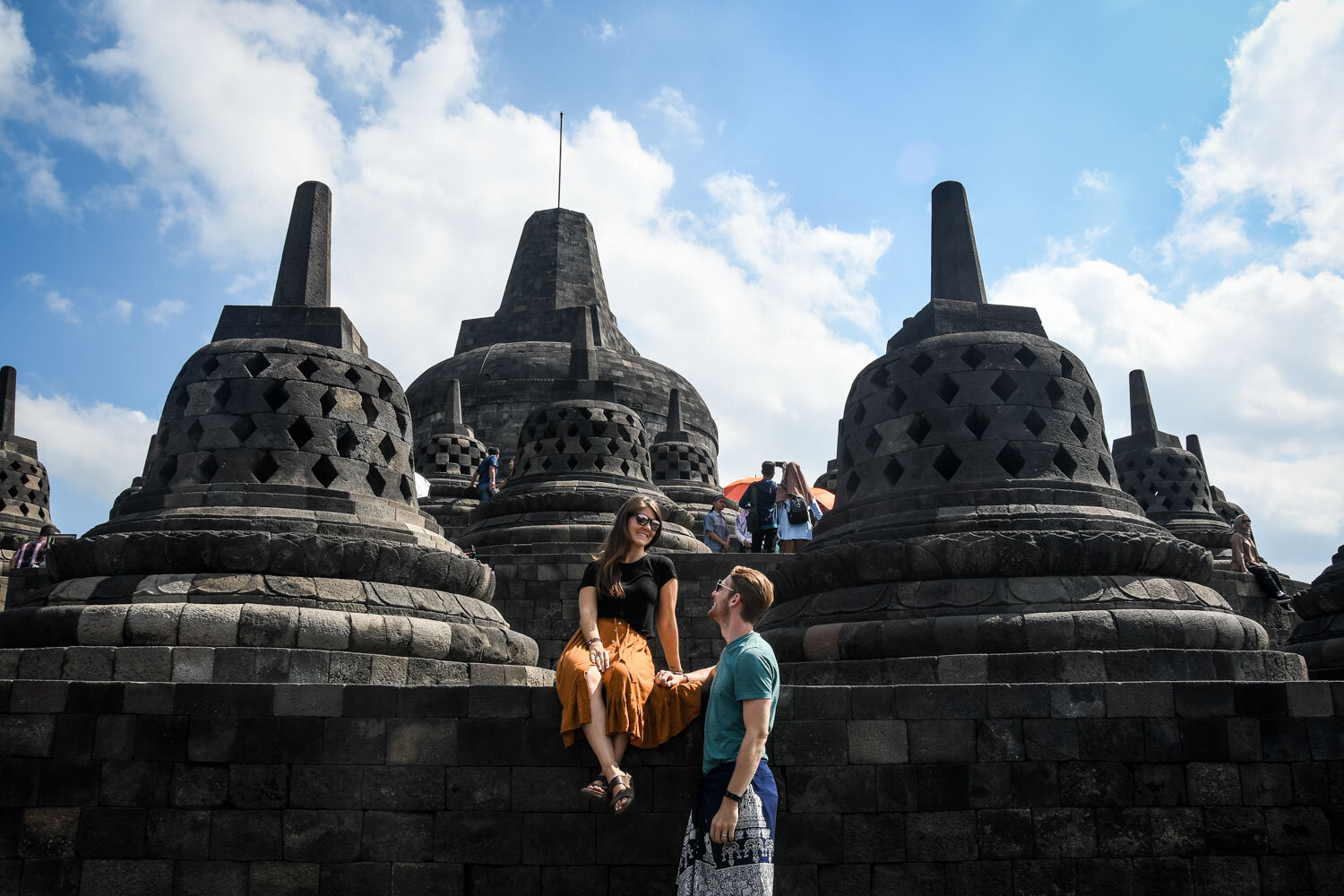
Here are some things to keep in mind for your visit to Borobudur:
-
Good to know: Borobudur is a popular place for Indonesian schools to bring students on field trips, so you will likely be stopped over and over again for photos and practice English.
-
It’s said that you are supposed to walk around the temple grounds 3 times in a clockwise fashion to show respect to the temple. We walked clockwise but lost track of how many rotations we did!
-
There isn’t much shade at Borobudur, so it can get hot quite quickly. By 9:30 a.m., we were getting sweaty (it doesn’t take much for us)! Be sure to wear sunscreen (especially if you’re a ginger like Ben!).
-
Getting out of Borobudur Temple is kind of a crazy experience. To begin with, they only allow you to exit on the far end of the temple (we tried to exit at the stairway nearest to the parking lot, but a security guard pointed us in the opposite direction). And when you finally reach the base of the complex, you will need to navigate a maze-like marketplace with vendors trying to sell all sorts of souvenirs.
-
If you’re hungry, you can grab a bite to eat near the parking lot where there are several food vendors serving simple meals.
-
Other stop nearby: If you have time, consider making a stop at the nearby “Chicken Church” (Gereja Ayam). It is just what it sounds like… a church shaped like a giant CHICKEN. Kind of interesting, really weird!
How long do you need at Borobudur Temple?
It depends on your personal style (aka how interested you are in the construction, how many photos you want to take, etc.).
Personally, we spent about 1.5 hours at Borobudur, and about 20 minutes of that time was spent talking to local students who asked for photos with us. Towards the end of our time there, we were getting really hot (and hangry!). It took us an additional 30 minutes to get out of the temple and eat lunch before hopping back on our motorbike and heading back to Yogyakarta.
Depending on your travel style, we’d say 1 – 3 hours at the complex in total would be sufficient.
How to get to Borobudur Temple from Yogyakarta
There are a few different ways to get to Borobudur temple, and the best one for you will depend on your budget and your comfort level with driving.
-
a) Go on a tour
-
b) Hire a driver
-
c) Go-Jek / Grab
-
d) Self-drive on a motorbike
You can book transportation through your guesthouse, sign up for a tour like this one, or you can drive yourself (which is what we did).
We’d only recommend the fourth option if you’re comfortable driving a motorbike; and we probably wouldn’t have gone this route if we had left before sunrise (aka in the dark).
The drive from Yogyakarta to Borobudur Temple took us roughly 1.5 hours (we left at 7 a.m. and arrived around 8:30 a.m.). On GPS it says it will take 1 hour, but with morning traffic, it took longer than expected.
Good to know: Candi (pronounced jchandi) is a Hindu or Buddhist temple in Indonesia, and you’ll see signs for Candi Borobudur and Candi Prambanan respectively. We were confused by this at first, and drove right past the entrance to Borobudur. Oops!
Hotels near Borobudur Temple
If you’re planning to see Borobudur at sunrise and have the time, we would have loved to stay near Borobudur for a night. You won’t have to wake up quite as early, which is a huge plus in our books!
There are plenty of hotels that look great, but these are the ones we would have chosen for ourselves:
Budget Hotels near Borobudur
For a budget stay, the three hotels listed below look really cute, have high reviews, free breakfast, and are walking distance to Borobudur. Can’t beat that or the $20 – $25 per night price tag!
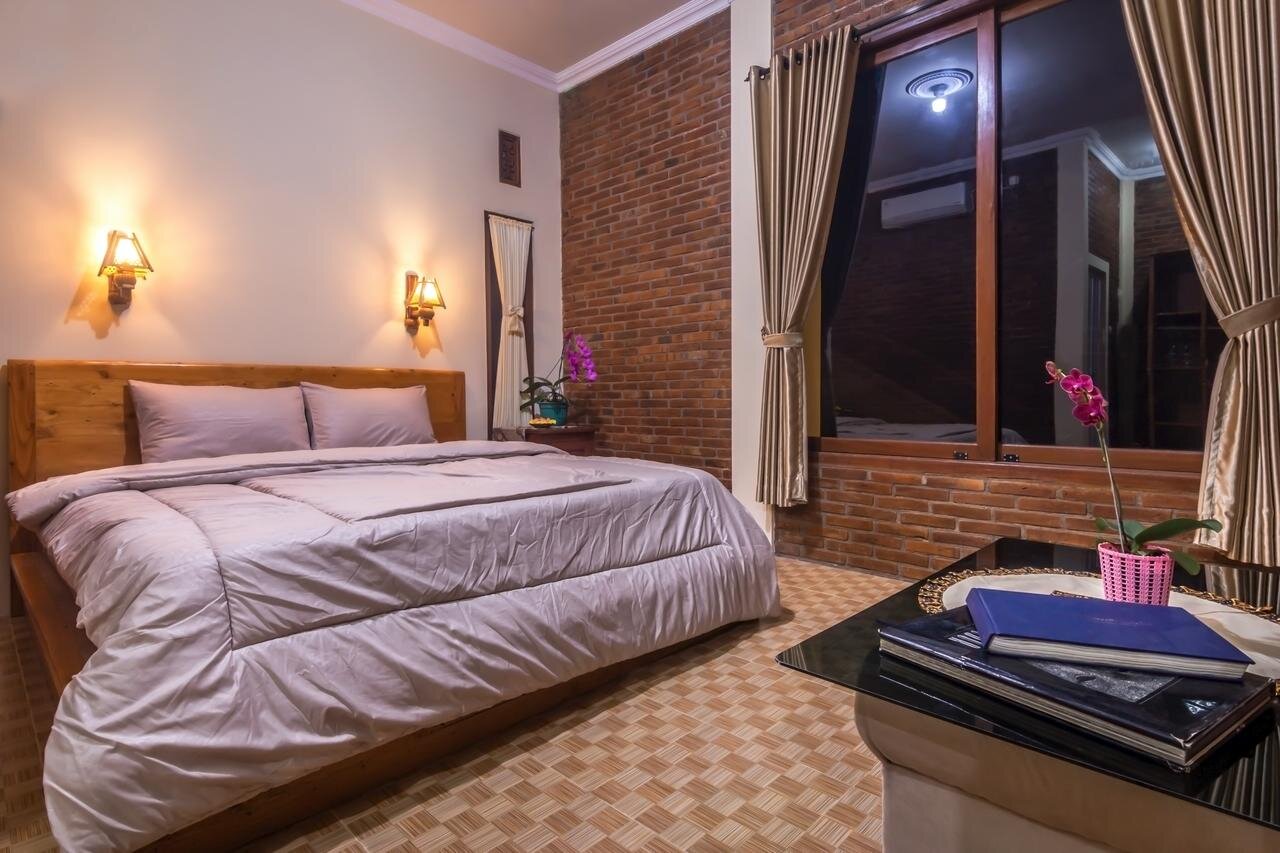
Maher House Borobudur: With nicely appointed ensuite rooms and a communal terrace with sweeping views, this property is a lovely and affordable choice. Plus, it’s just a short 10-minute walk to Borobudur.
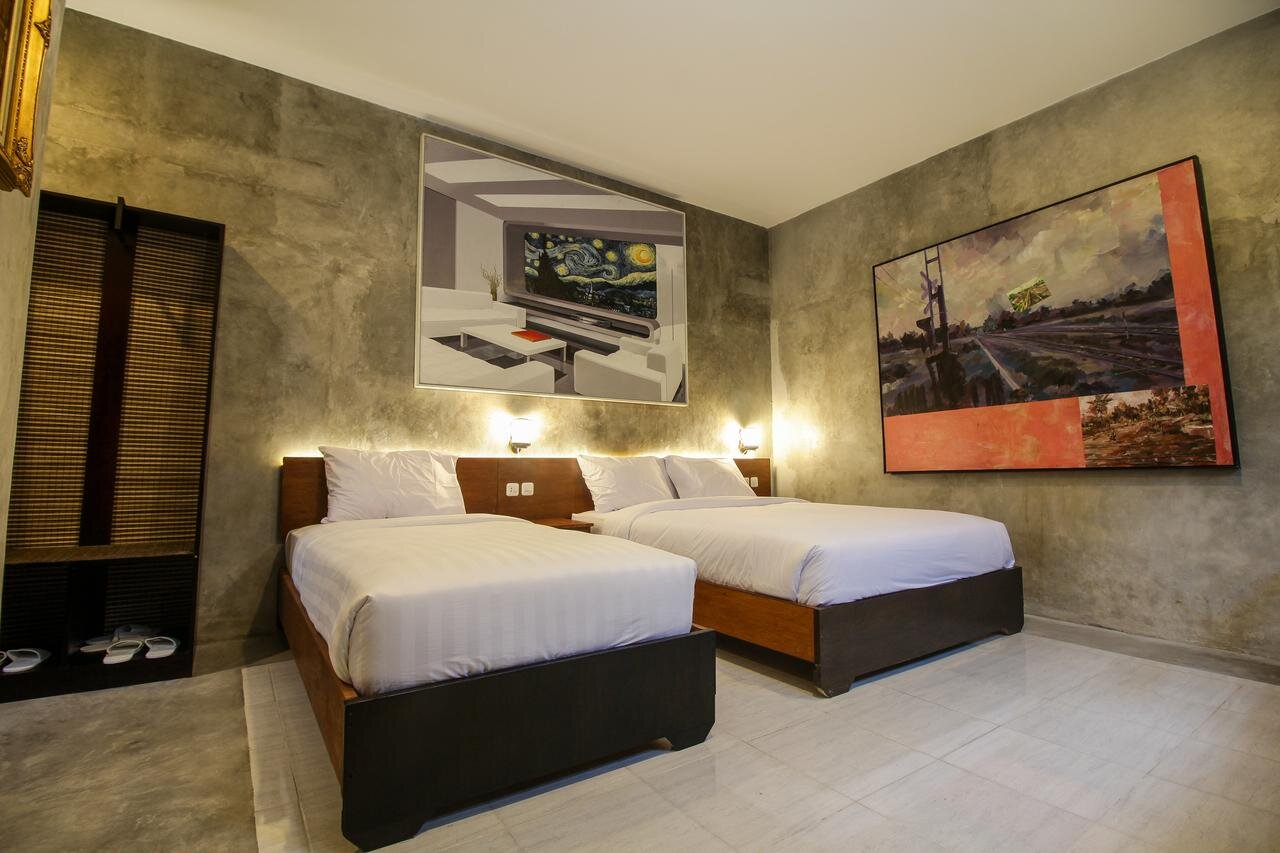
Watu Agung Guest House: With clean, comfortable rooms and a nice breakfast, this makes a good budget stay.
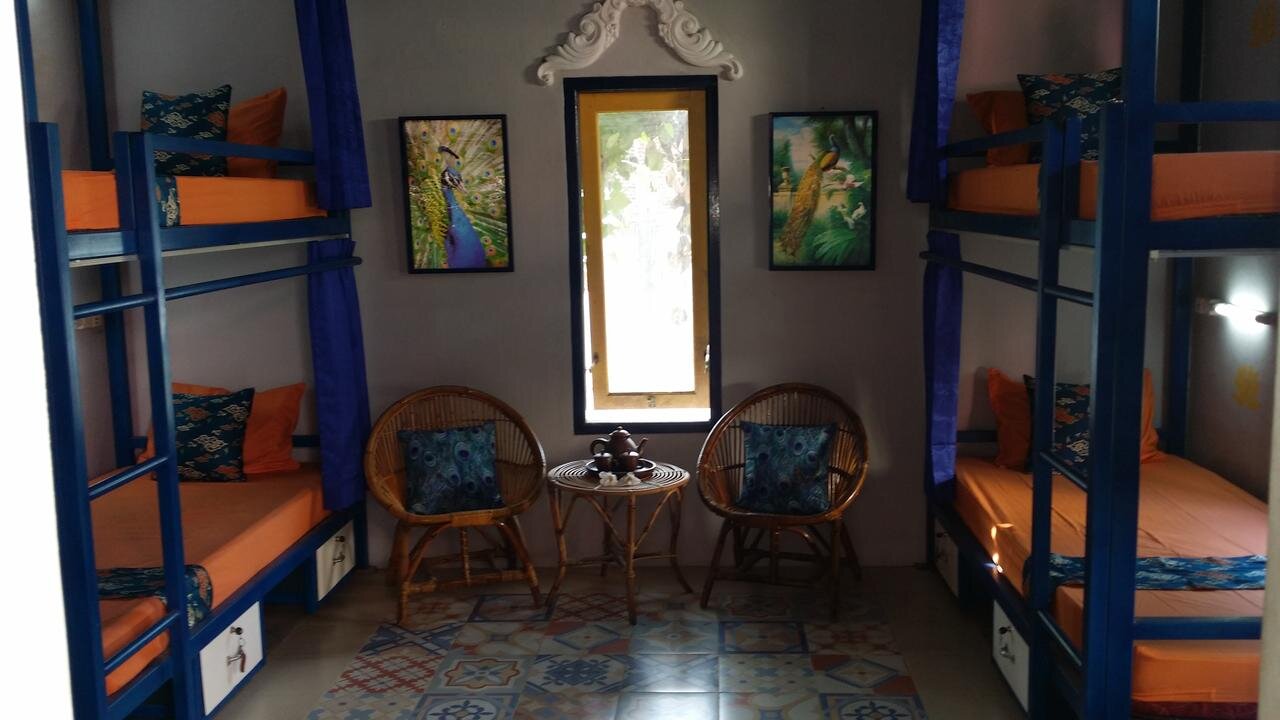
Jaswan Inn Borobudur: If you’re traveling solo, this guesthouse has both private rooms and dorm options all at one of the cheapest rates in town. Plus, they’ve earned rave reviews from past guests.
Mid-range Hotels (with pools!) near Borobudur
If you’re looking to cool down after an early morning at Borobudur, you’ll want to book a hotel with a pool. The options listed below are highly-rated, very affordable, and have a pool for guests!
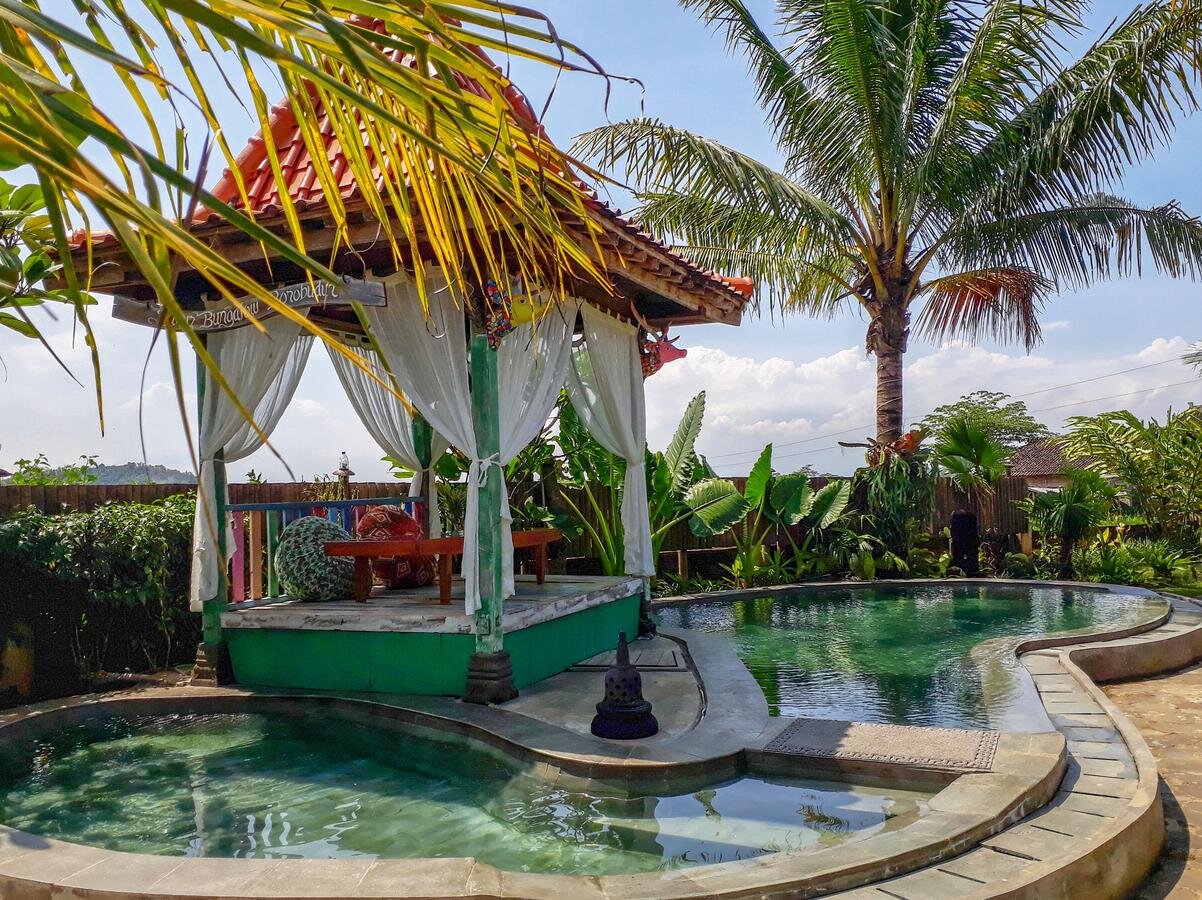
Janur Bungalow: This is the hotel we would personally choose! With a beautiful boho design, a lovely pool, and a nice breakfast all for a reasonable price, we’re in love with this property!
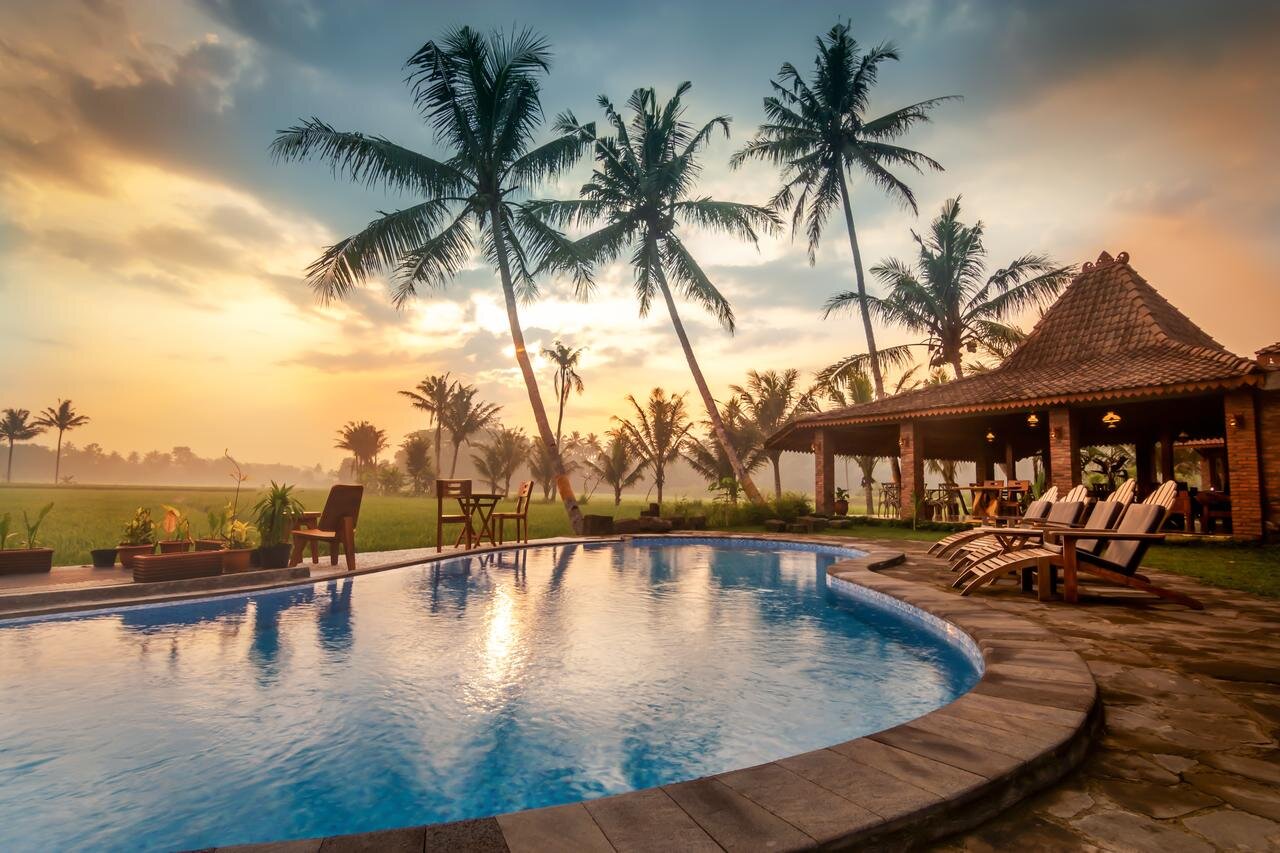
Gopalan Borobudur: With comfortable air-conditioned rooms and a pool, this guesthouse makes another great choice. It’s hard to beat this price, which is just a bit more money than the budget options listed in the section above.
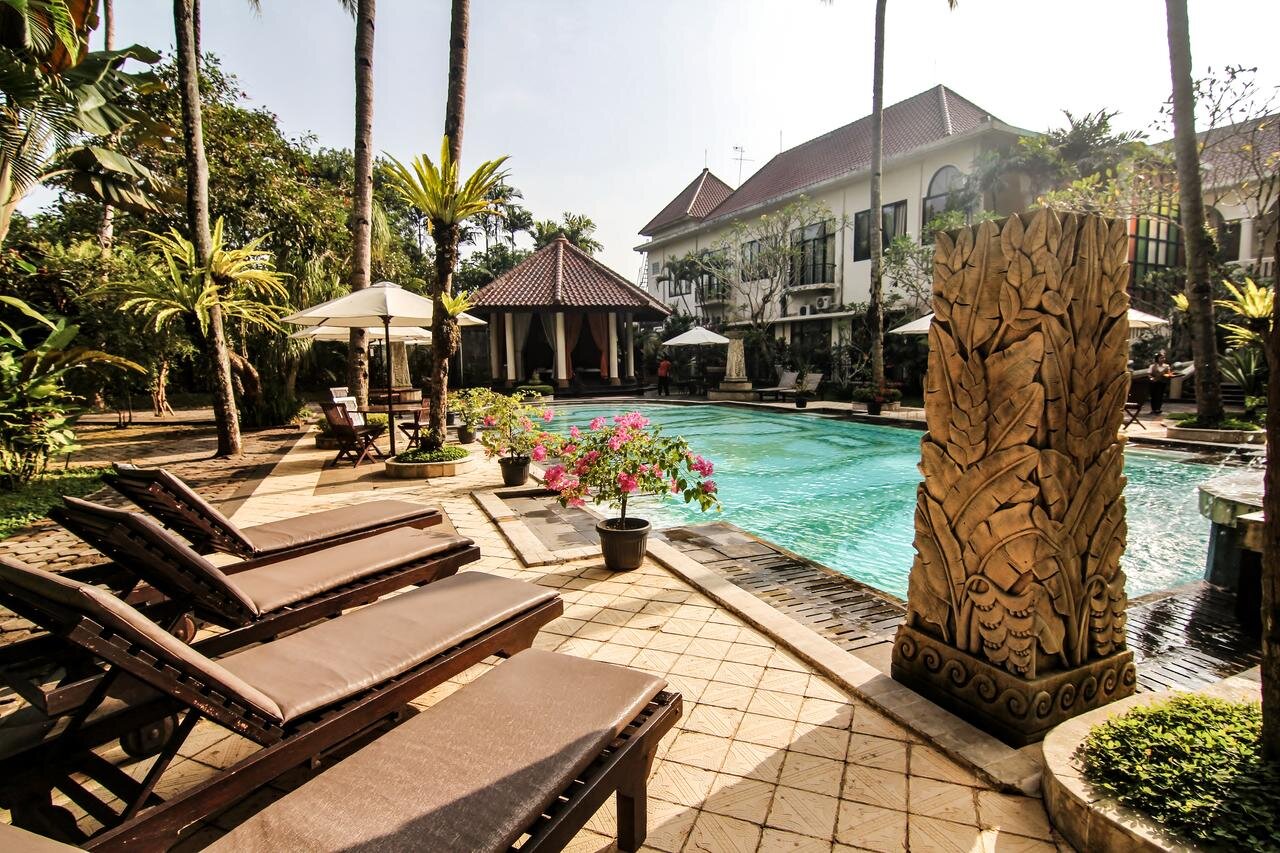
Sarasvati Borobudur: If it’s luxury you’re looking for, this might be your top pick. While it’s the most expensive property on this list, a room isn’t going to break the bank (a standard queen room starts at just $67 USD). And their swimming pools is stunning!
Guide to Visiting Prambanan Temple
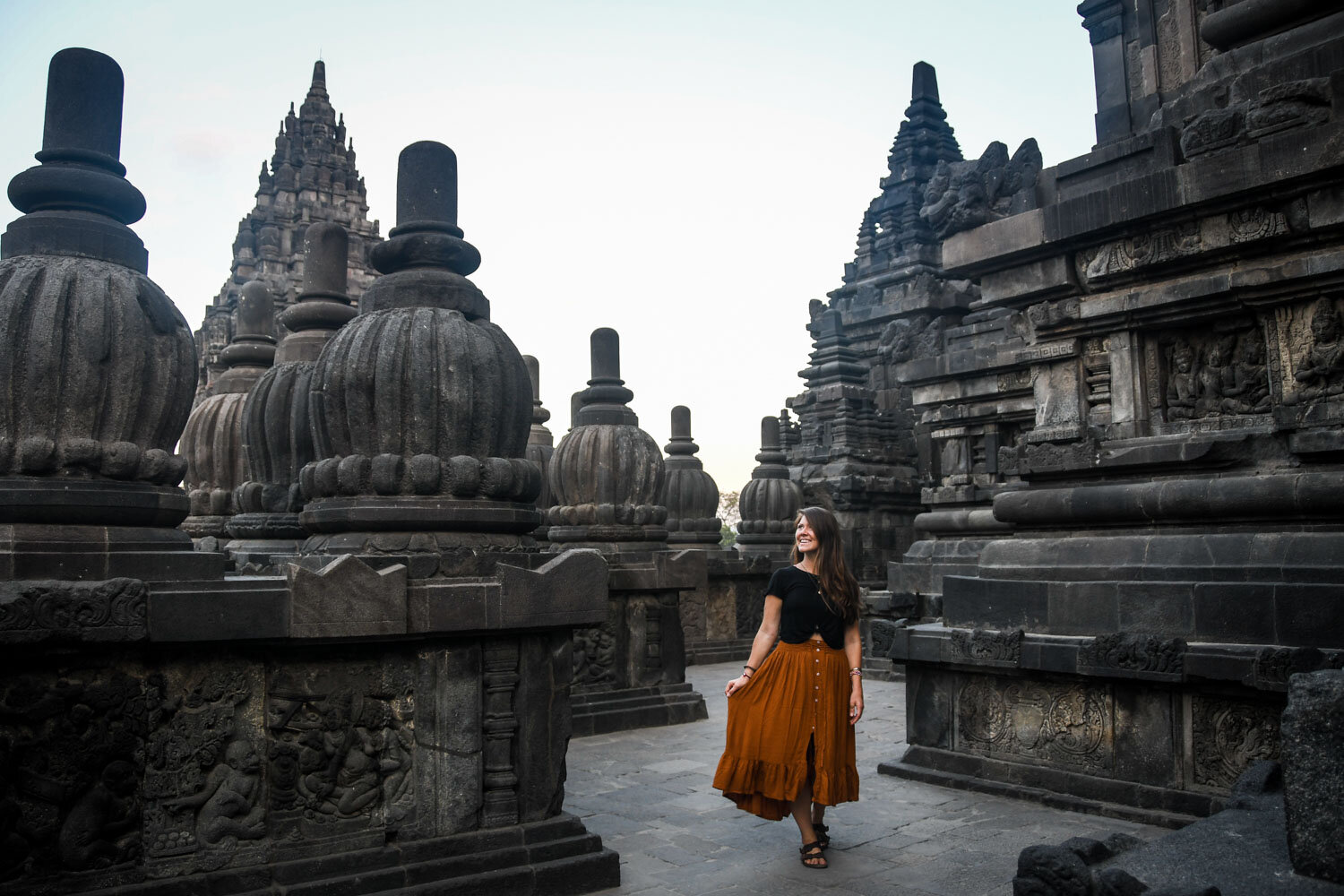
This complex of Hindu temples was built in the 10th century, and is Indonesia’s largest compound dedicated to Shiva. Encompassing 240 temples, the grounds of Prambanan feels undeniably similar to Cambodia’s iconic Angkor Wat, albeit much, much smaller and not quite as impressive.
Prambanan Temple Basic Info
-
Hindu Temple
-
UNESCO World Heritage Site
-
Visiting Hours: every day from 6 a.m. to 5 p.m.
-
once you’re inside, you can stay within the complex until 6 p.m.
-
-
Toilets: There are clean restrooms near the entrance. There was toilet paper when we were there; but while traveling in Java, we always carried some (just in case) in our backpack.
-
Crowds: Prambanan is most crowded on weekends and holidays, as well as midday and late afternoon.
-
Guide: It is possible to hire an English speaking guide on site, or book a tour that includes transportation.
Prambanan Temple Entrance Fee
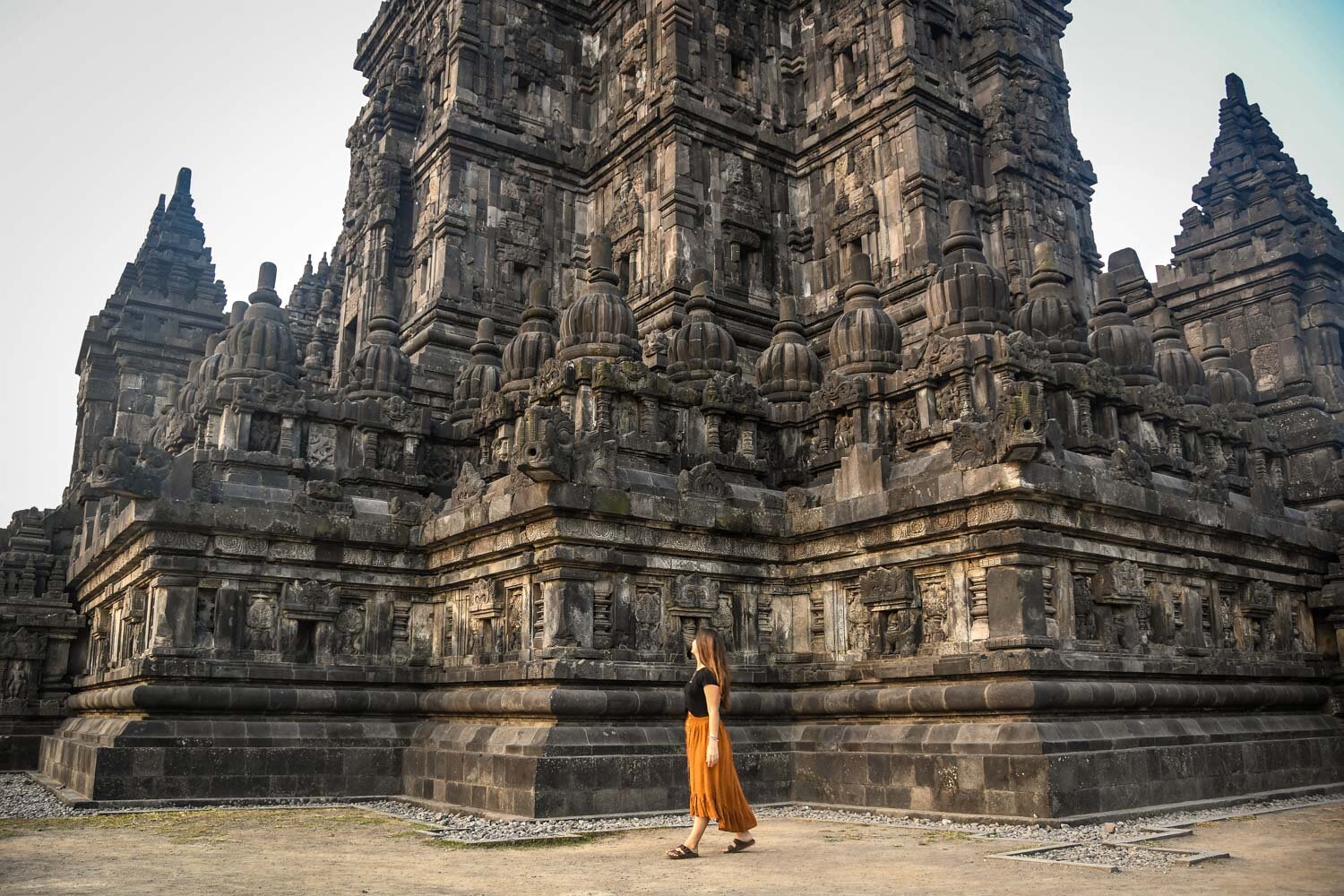
See below for all ticket prices (as of April 2020). Ticket prices seem to increase each year, so keep this in mind as you plan your trip.
Important Note: Below are the prices for REGULAR tickets. We have more information below on the Borobudur + Prambanan Combo Discount Ticket.
Adult
-
Foreign Visitor: $25 USD (390,000 IDR)
-
Domestic Visitor: $3.50 USD (55,000 IDR)
Student (must show your valid student ID)
-
Foreign Student: $15 USD (230,000 IDR)
-
Domestic Student: $1.75 USD (27,000 IDR)
Are you a student? Bring your student ID (we’ve even heard a photo of your ID can work) and get an additional 40% off the total ticket price.
Child (6 – 10 years old)
-
Foreign Child: $15 USD (230,000 IDR)
-
Domestic Child: $1.75 USD (27,000 IDR)
Good to know: You can pay with credit card or cash (Indonesian rupiah). The price in USD is set, but the amount in IDR can fluctuate depending on the current conversion rate.
Quick History & Interesting Facts about Prambanan
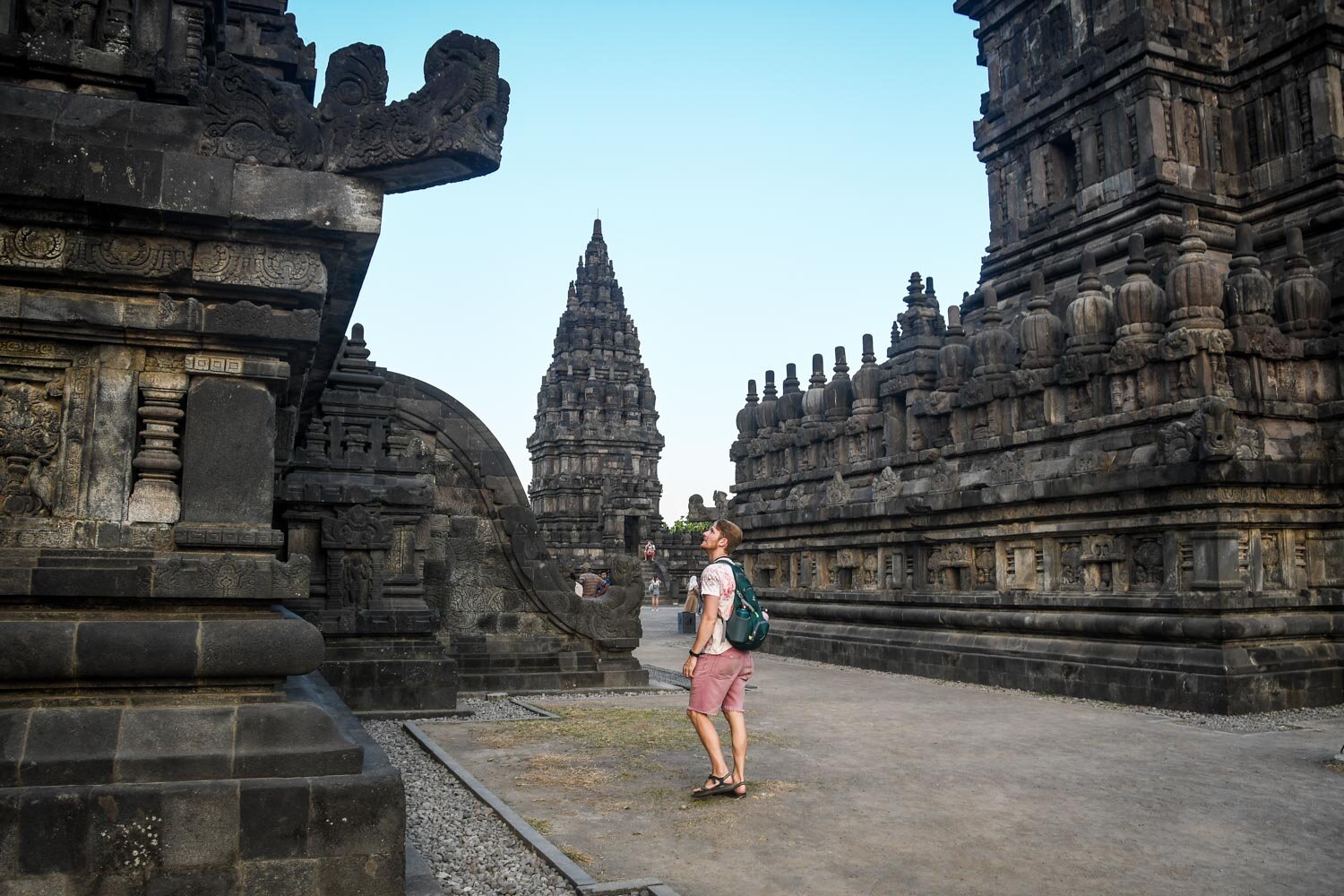
-
Prambanan was built during the mid-9th century (around the year 850 CE), during the Hindu Sanjaya Dynasty’s reign.
-
Prambanan is the largest Hindu complex in Indonesia (even though the island of Bali has much stronger ties to this religion today). It is the second largest Hindu temple site in all of Southeast Asia (the first being Angkor Wat in Cambodia).
-
The complex originally had a total of 240 temples.
-
The main attraction in Prambanan are the 3 Trimurti temples. Trimurti is Sanskrit for “three forms”, and refers to God as the Creator (Brahma), the Preserver (Vishnu) and the Destroyer (Shiva).
-
The most impressive temple in this complex is dedicated to Shiva. This temple is the tallest structure in Prambanan, measuring 47 meters (154 feet) tall.
-
In 2006, Prambanan was greatly damaged by an earthquake that hit Central Java. Even to this day, visitors can see some large piles of debris still scattered on the ground as experts are carefully reassembling these precious pieces of history.
The Legend of Prambanan Temple
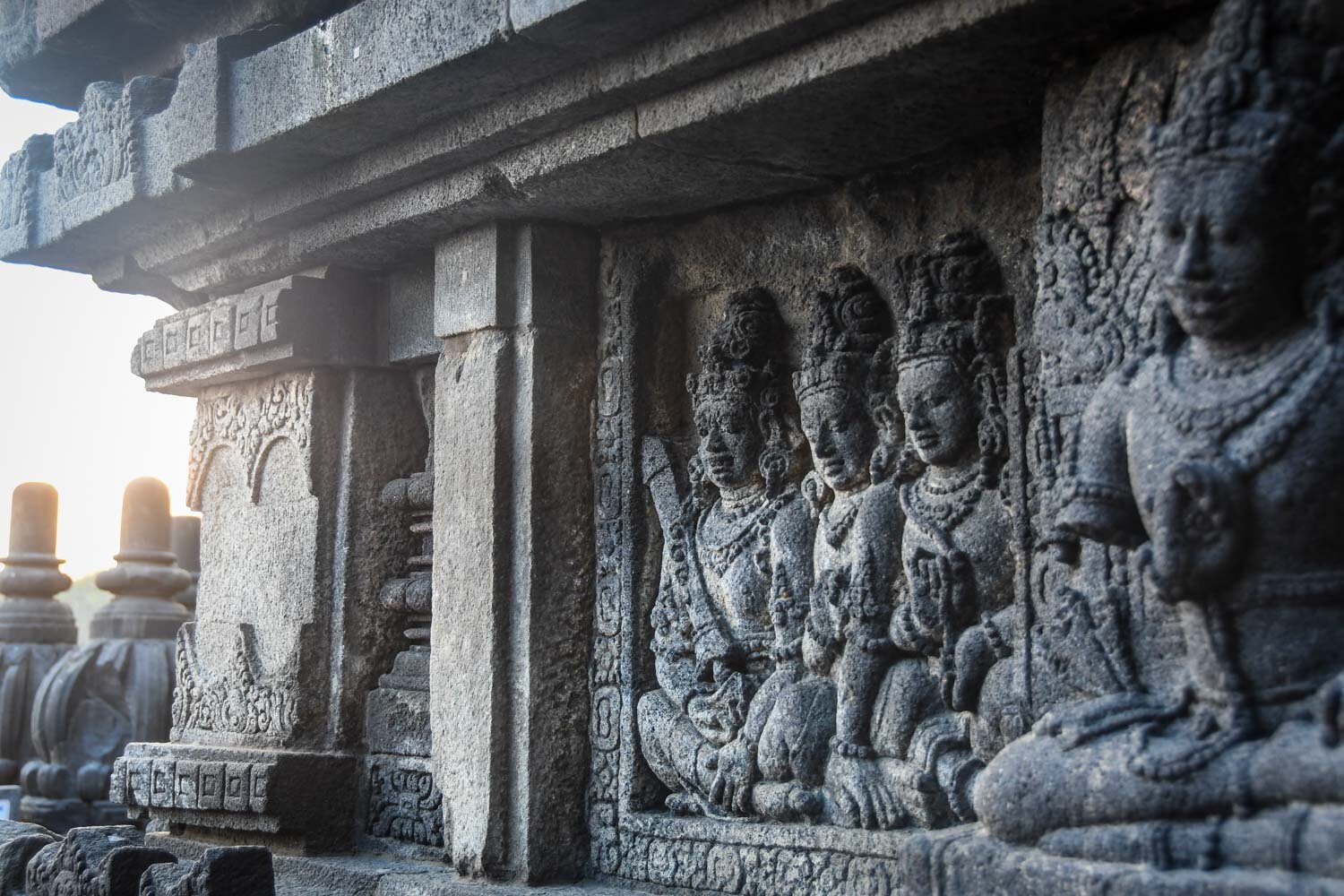
There was once a king that fell in love with a beautiful princess and asked for her hand in marriage. She didn’t want to marry him, but knew she couldn’t refuse his proposal so she made an impossible deal: He needed to build her 1,000 temples before sunrise, and then she would marry him.
The king agreed and called upon the spirits to help him. He was very close to completing all the temples, and the princess knew he had to be stopped. She asked all the women in the village to pound rice and the men to burn wood. This commotion scared the spirits away when they were just one temple away from finishing the task.
When the king learned he had been fooled, he was so upset that he turned the princess into a stone statue and placed her inside what is now known as Prambanan. It is said that you can see this statue of a woman who is the princess, stuck in stone for eternity (though we must have missed her!).
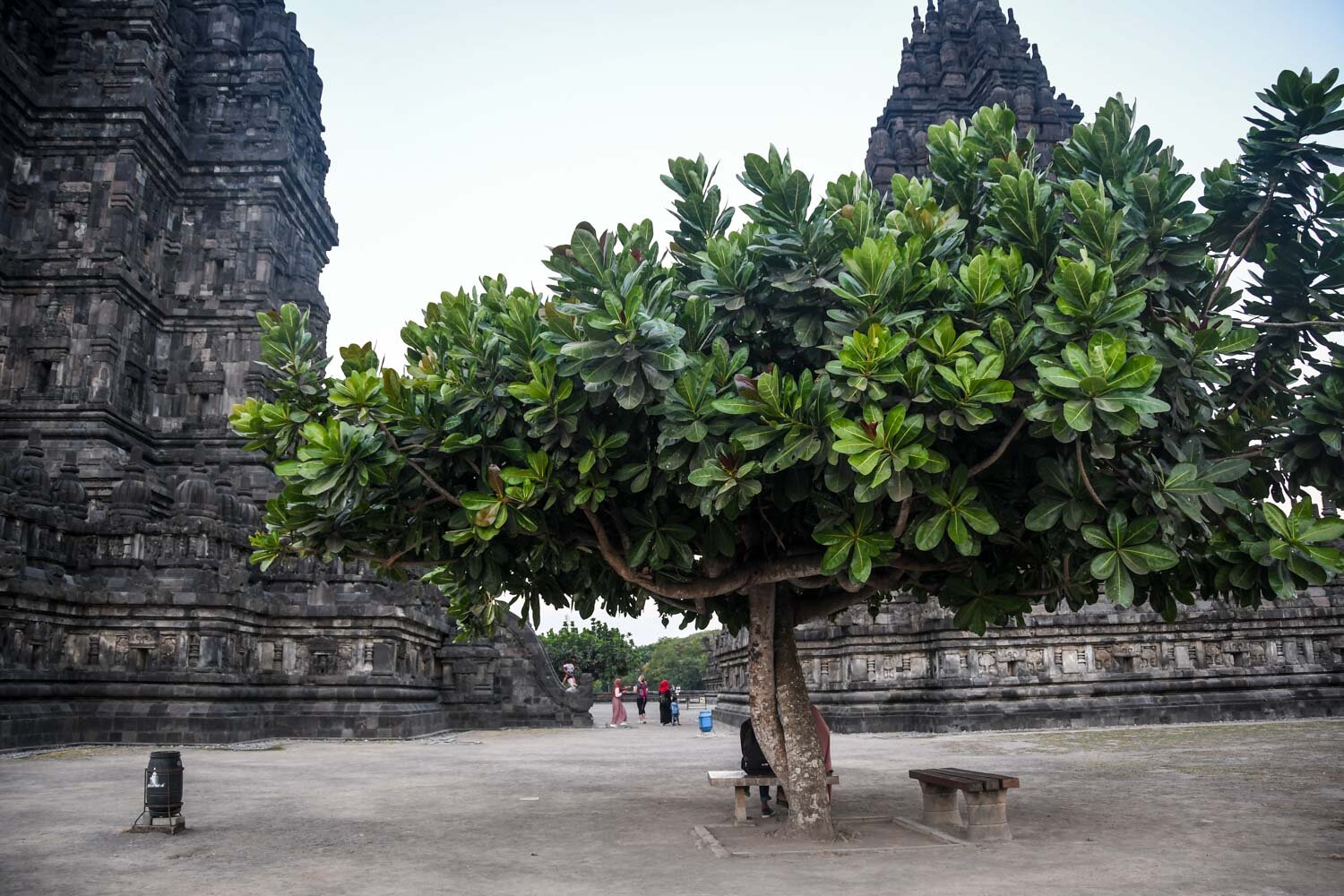
Best time to visit Prambanan Temple
-
Visiting Hours: every day from 6 a.m. to 5 p.m.
-
once you’re inside, you can stay within the complex until 6 p.m.
-
Morning or late Afternoon
Morning or late afternoon are both nice at Prambanan. However, if you want to visit both Borobudur and Prambanan on the same day, we’d recommend seeing Borobudur in the morning and Prambanan in the afternoon.
When to avoid: We’d recommend staying away during midday because the ultra-hot, blood boiling temperatures are not enjoyable.
We arrived in the late afternoon to see the temples cast in a lovely pink glow as the sun sank in the sky. And actually, we found the late afternoon to be not as crowded as we were expecting.
Our experience at Prambanan Temple
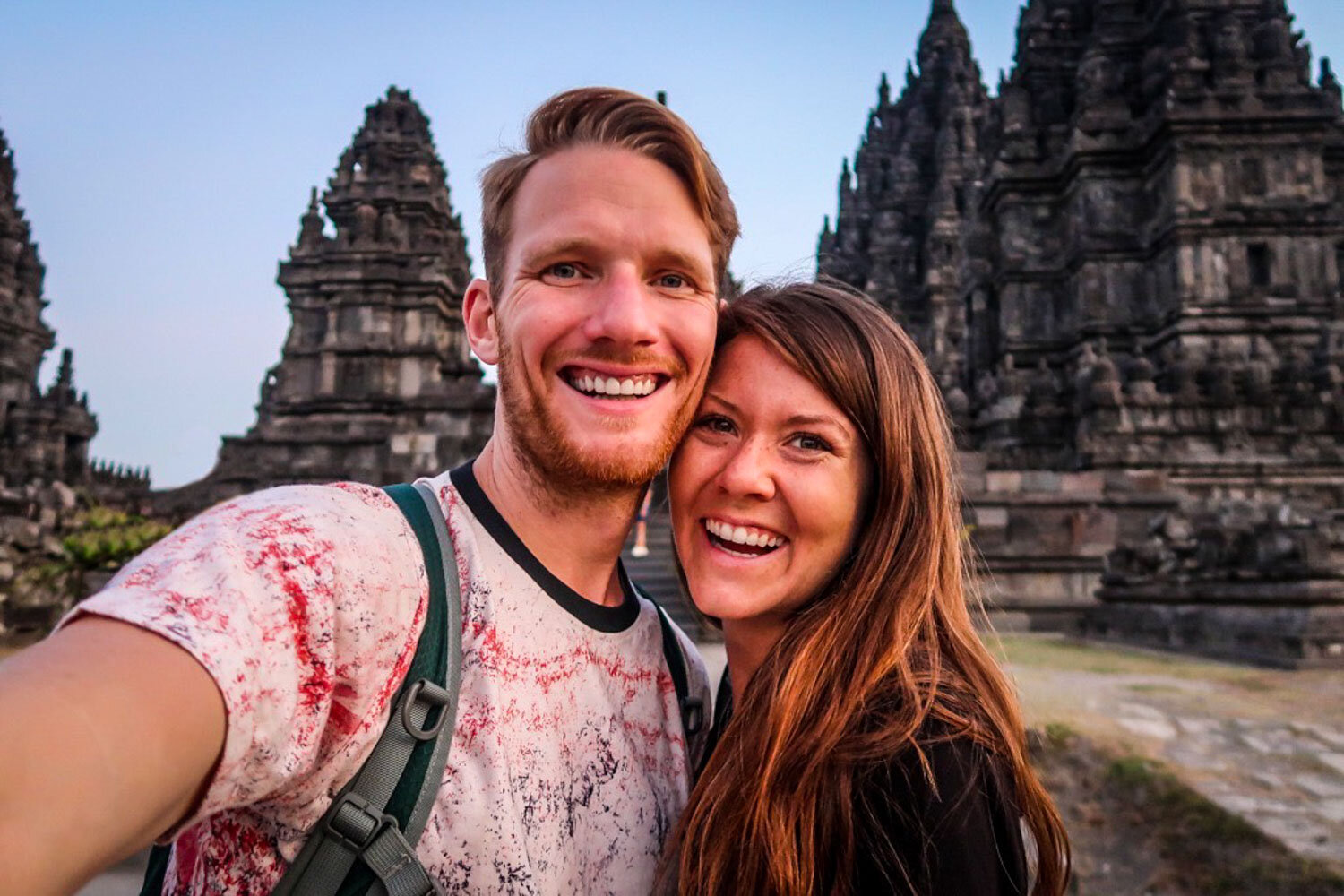
We didn’t come to Prambanan with many expectations. Most of the photos we had seen before our trip were of Borobudur, and I guess that was the temple that we were more excited for. Also, we had been to Angkor Wat a few years before, so we didn’t want to be let down since they are often compared.
Perhaps it was partly due to our somewhat low expectations, but we really enjoyed Prambanan. True, it is nowhere near as large or complex as Angkor Wat, nor as iconic as Borobudur, but it was fun being able to wander through all the different temples. There are lots of nooks and crannies to explore, hidden “rooms”, and reliefs carved into almost every surface.
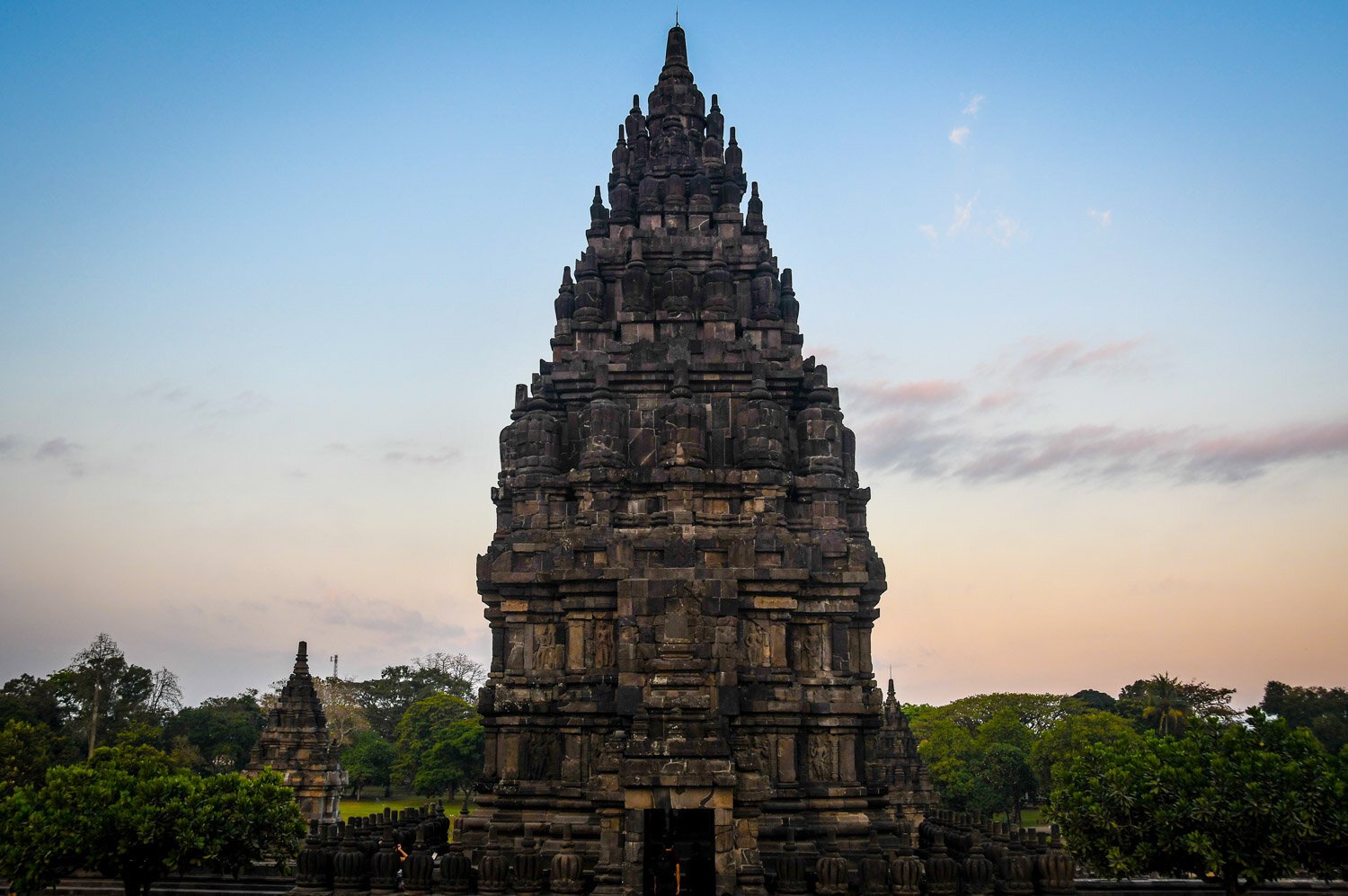
We arrived shortly before sunset, and the crowd started thinning as the sky turned pink. Bells started ringing as a nearby mosque broadcast the call to prayer. We sat on a bench and just took in the view of the temple in front of us as a breeze started to lift the heat from the day.
While it’s not the most impressive temple we’ve ever visited, it was nice to see nonetheless.
What to wear at Prambanan Temple
Just like Borobudur (or any other temple), it’s important to cover your knees and shoulders as a sign of respect. Ben’s shorts were just a tad too short, so he was given a sarong to tie around his waist for free. We try to come prepared with appropriate clothing, but it’s good to know that there are sarongs available in case you need them.
Insider Tips for visiting Prambanan Temple
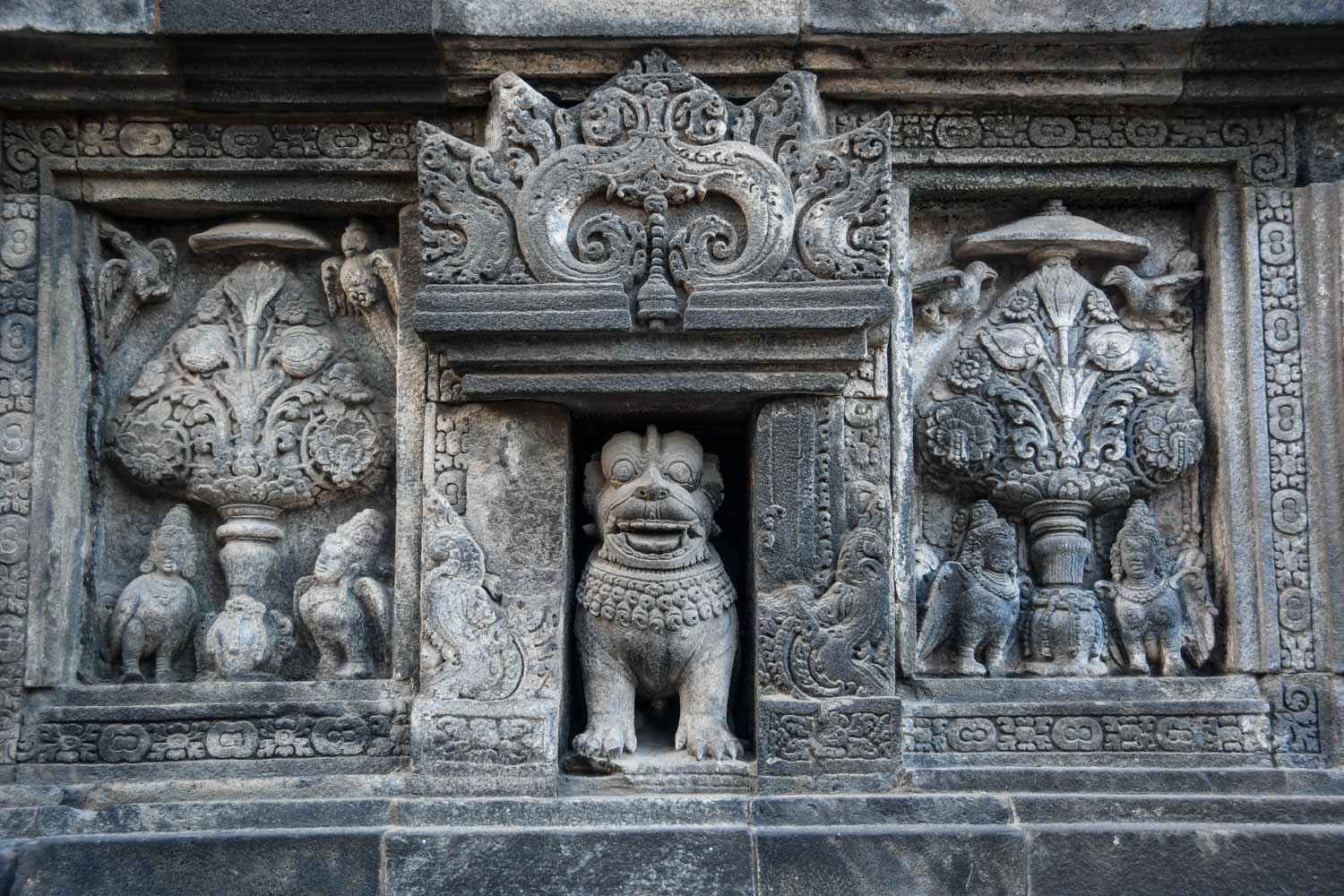
-
On the main (Shiva) temple, look for the bas-relief carvings. They tell the story of Ramayana, starting from the east side and continuing around the temple clockwise.
-
It’s possible to rent a bicycle (for a reasonable price) inside the archaeological park that encompasses Prambanan. This makes it easy to see as much of the complex as possible without getting tired from walking.
-
Tummy rumbling?! If you’re looking for food (and are on a budget), there are a few local warungs nearby. They serve super cheap, authentic noodle dishes in a no-frills, plastic chair type atmosphere. We popped into one and enjoyed some mie ayam (chicken and fried noodles) and had fun trying to play with the owner’s small daughter. Our total bill for 2 meals and a coconut was 39,000 IRD ($2.75 USD). Can’t beat that!
-
For a “nicer” nearby restaurant with a view, Abhayagiri is just south of the temple and is said to have a beautiful location and is especially nice at sunset. We’ve heard it’s quite expensive and have read mixed reviews on the food, so it might not be for everyone. But check it out and see if it looks like your scene.
-
If you have the time (and interest), there are many other lesser-known temples nearby Prambanan:
-
Candi Sewu: Located at the very north end of the Prambanan complex, this temple often gets overlooked, but it’s very beautiful.
-
Ratu Boko makes for some nice silhouette pictures in the late afternoon and there is a free shuttle that departs every 15 minutes (last departure at 2:30 p.m.).
-
Plaosan Temple resembles Prambanan, but is less popular (and thus, less crowded!).
-
How long do you need at Prambanan Temple?
If you plan to just explore the main temple (Shiva temple), you’ll need around 1 hour. However, if you want to explore more of this archaeological park and see the other temples in the complex, allow at least 2 hours. Everyone has their own pace.
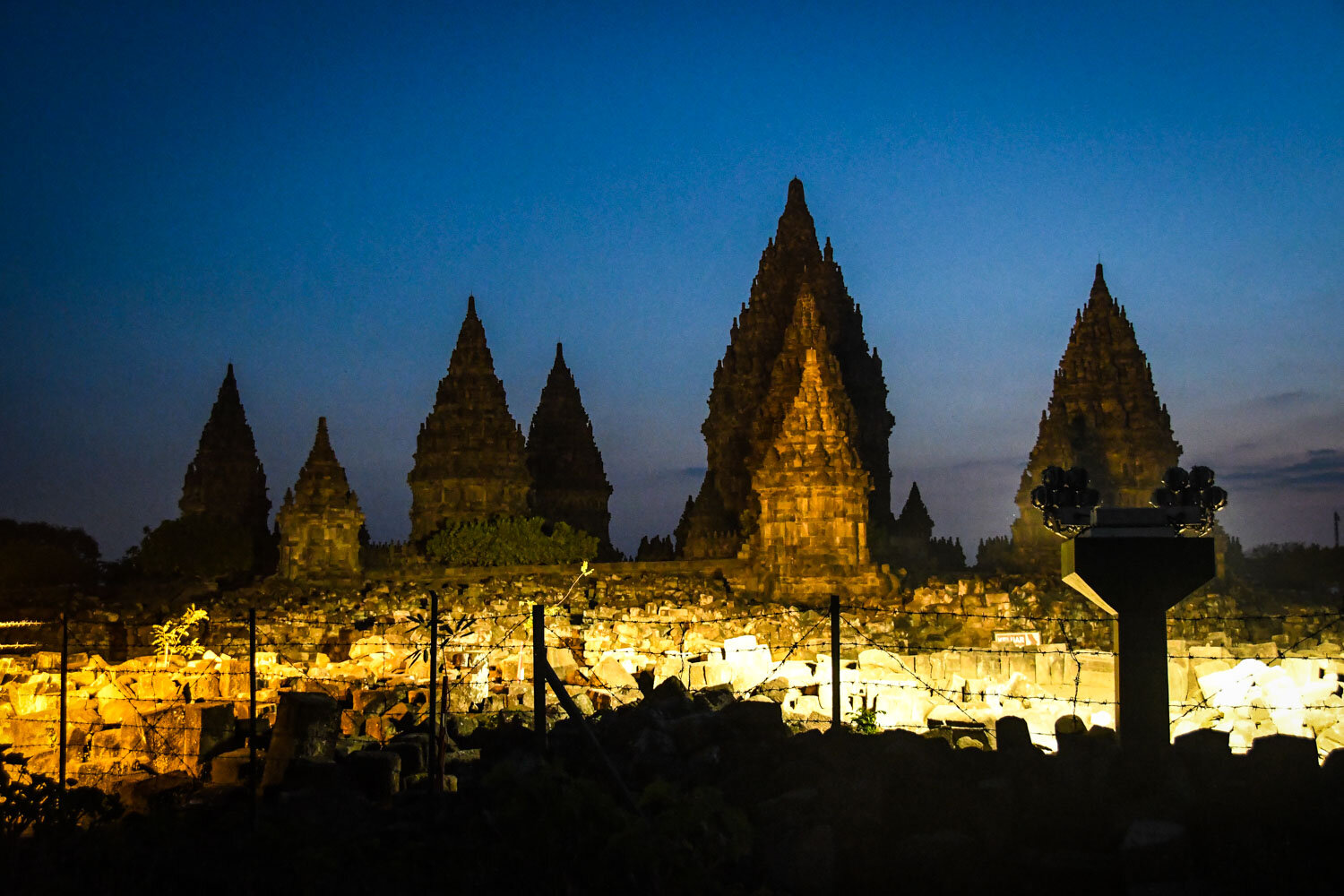
How to get to Prambanan Temple
The Prambanan Temple complex is about 17 kilometers (11 miles) northeast of Yogyakarta and there are a few ways to get to there:
-
Take a guided tour: This would be the easiest way since you get picked up inJogja and driven to the temples with a guide to explain it all to you.
-
Ride sharing: Use the Grab or Go-Jek apps (Indonesia’s Uber) and get a ride there. It would take about 45 minutes from the city and costs around 120,000 IDR for a car ($7.75 USD). If you are alone, you could also hire a ride share motorbike and it would be half the price and quite the adventure.
-
Drive yourself on a motorbike: We would only recommend this option if you have experience driving a motorbike in Indonesia before, as Yogyakarta is not the best location to learn. Use Google Maps to get your there, but ignore the timing because it will take you about 1 hour from the city just before sunset. And please wear a helmet!
-
Public Transportation: The cheapest way to get to the Prambanan Temple is to take the local bus (Trans Jogja bus) as it will only cost you 4,000 IDR per person. We did not choose this option because it would have taken a lot of time because you have to take one bus to the airport and then transfer to the Prambanan shuttle. If you want to do this route to and from the temple, we would recommend asking your hotel staff for help and directions.
Hotels near Prambanan Temple
We’d recommend staying in Yogyakarta and making the drive to Prambanan since it’s not quite as far as Borobudur.
Our hotel recommendation for Yogyakarta:
Nextdoor Homestay: This is where we stayed in Jogja, and we loved the affordable price, the delicious breakfast, the friendly staff, and the small (but nice!) pool for cooling off in the midday heat.
Psst! You’ll find many more hotel recs on our Yogyakarta guide!
Ramayana Ballet at Prambanan
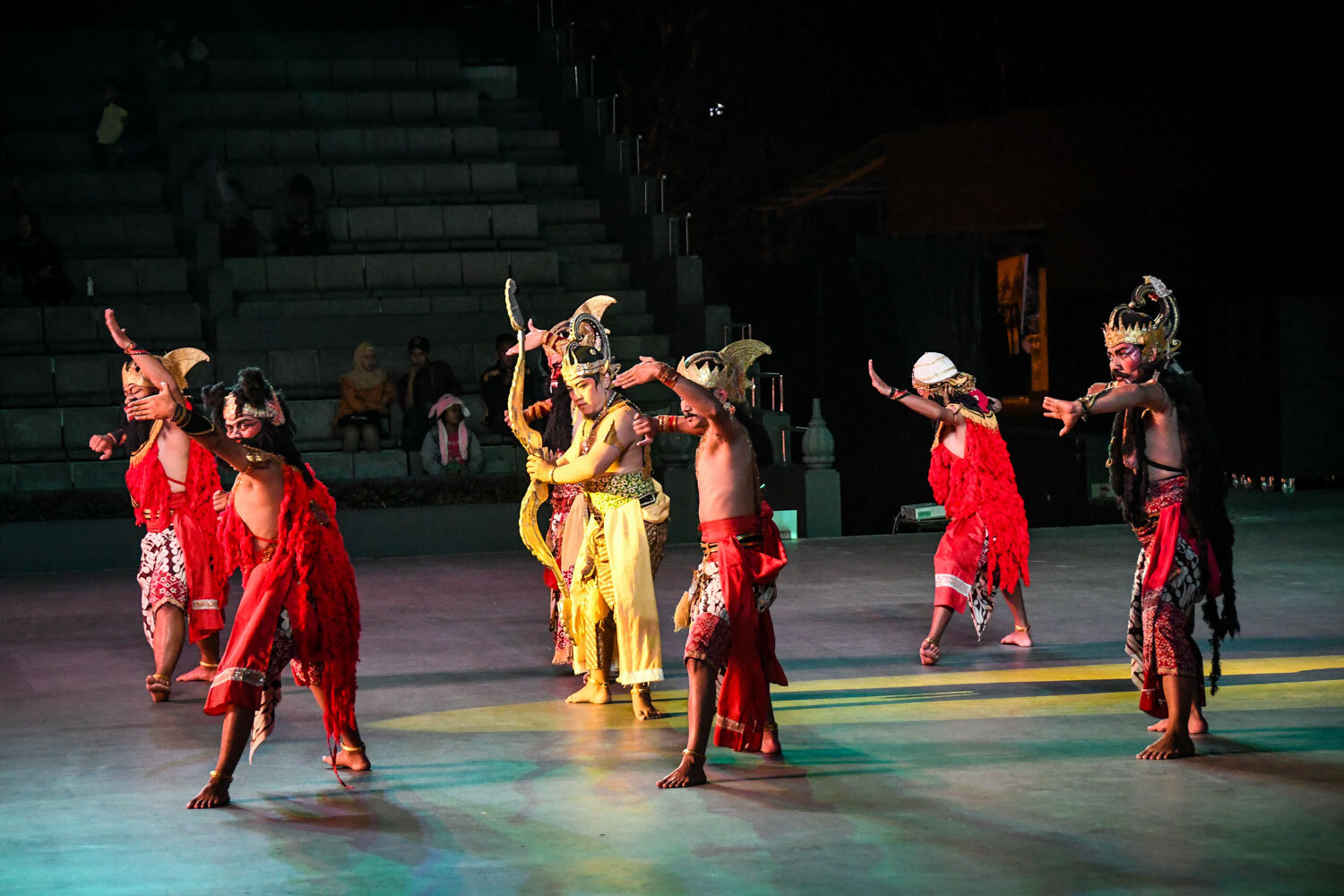

While doing some research about things to do in Jogja, we read that there was a ballet performed on the grounds of Prambanan Temple a few days a week. Sounded cool, so we had our guesthouse arrange tickets for us.
But before we go any further, we want to clear one thing up: It’s not a ballet like you’re imagining, but instead a traditional Javanese / Hindu dance.
It tells the famous story of Ramayana, one of the most famous Sanskrit epic poems from ancient India. This classic Hindu story involves a beautiful princess, kidnapping, fighting, and seduction. This story performed in traditional dance is an experience culture-lovers will appreciate.
Is the Prambanan Ballet worthwhile?
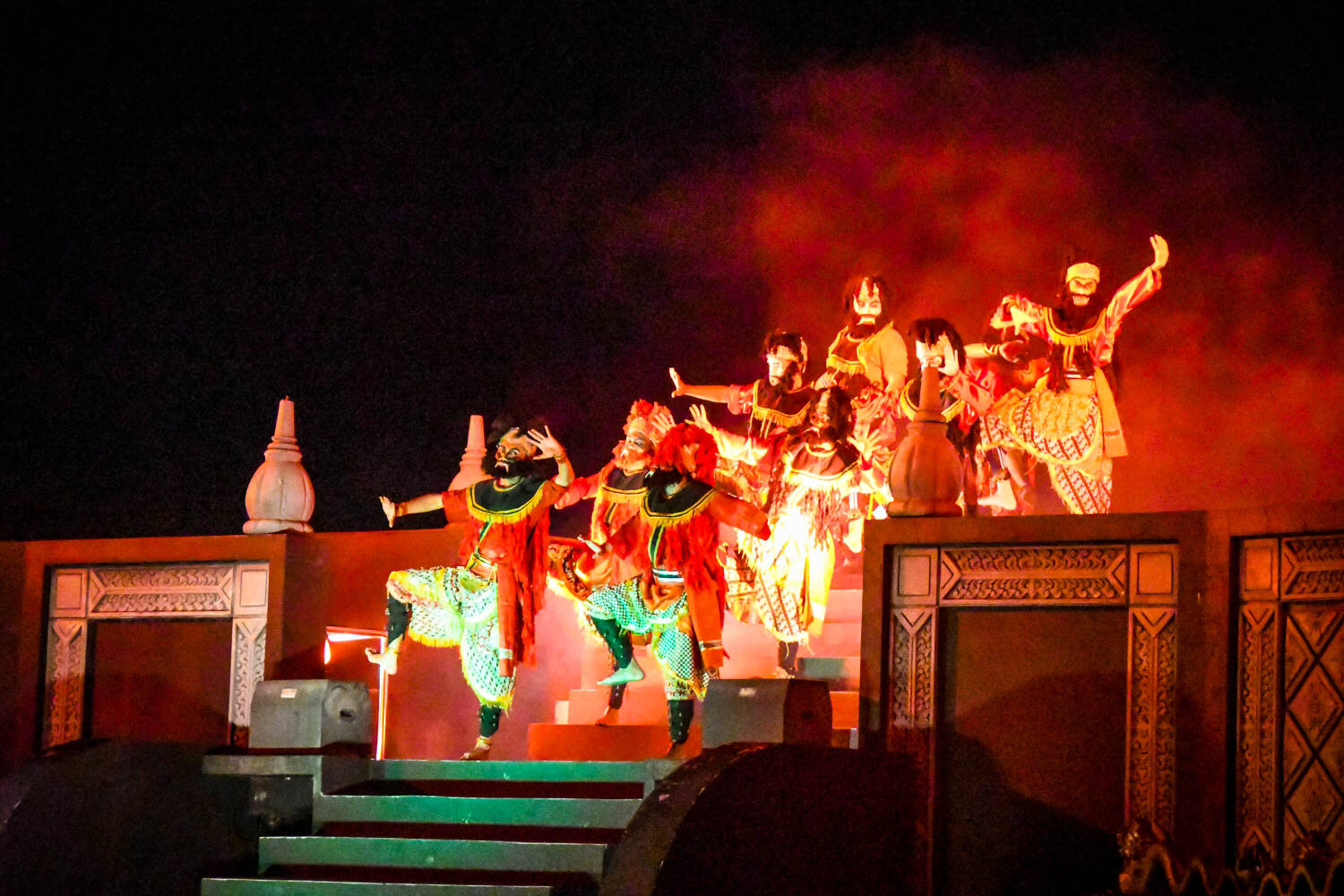

So, did it live up to our expectations? Would we recommend it to others?
It depends… Below, we’re going over what to expect, because we think it’ll be well worth it for some travelers, and something to skip for others.
Our honest opinion: We have seen this story performed twice in Bali, and by comparison, this version was not nearly as good. It was kind of neat to stay on the grounds of Prambanan after dark, but we got bored pretty quickly. It’s also good to know that the cement seats were quite uncomfortable after a while.
If you are interested in the Hindu religion and are not planning to visit Bali on your trip to Indonesia, this is a good way to spend an evening. However, if you’re also traveling to Bali, we’d recommend seeing the Kecak Fire Dance there, as it was put together better (in our opinions).
Insider Tip: No matter where you see this performance, it’s a good idea to read up on the story ahead of time so you understand what’s going on. There are English subtitles projected during the performance, however, you’ll be able to enjoy it much more if you already know a bit about the storyline.
Important info about the Ramayana Ballet:
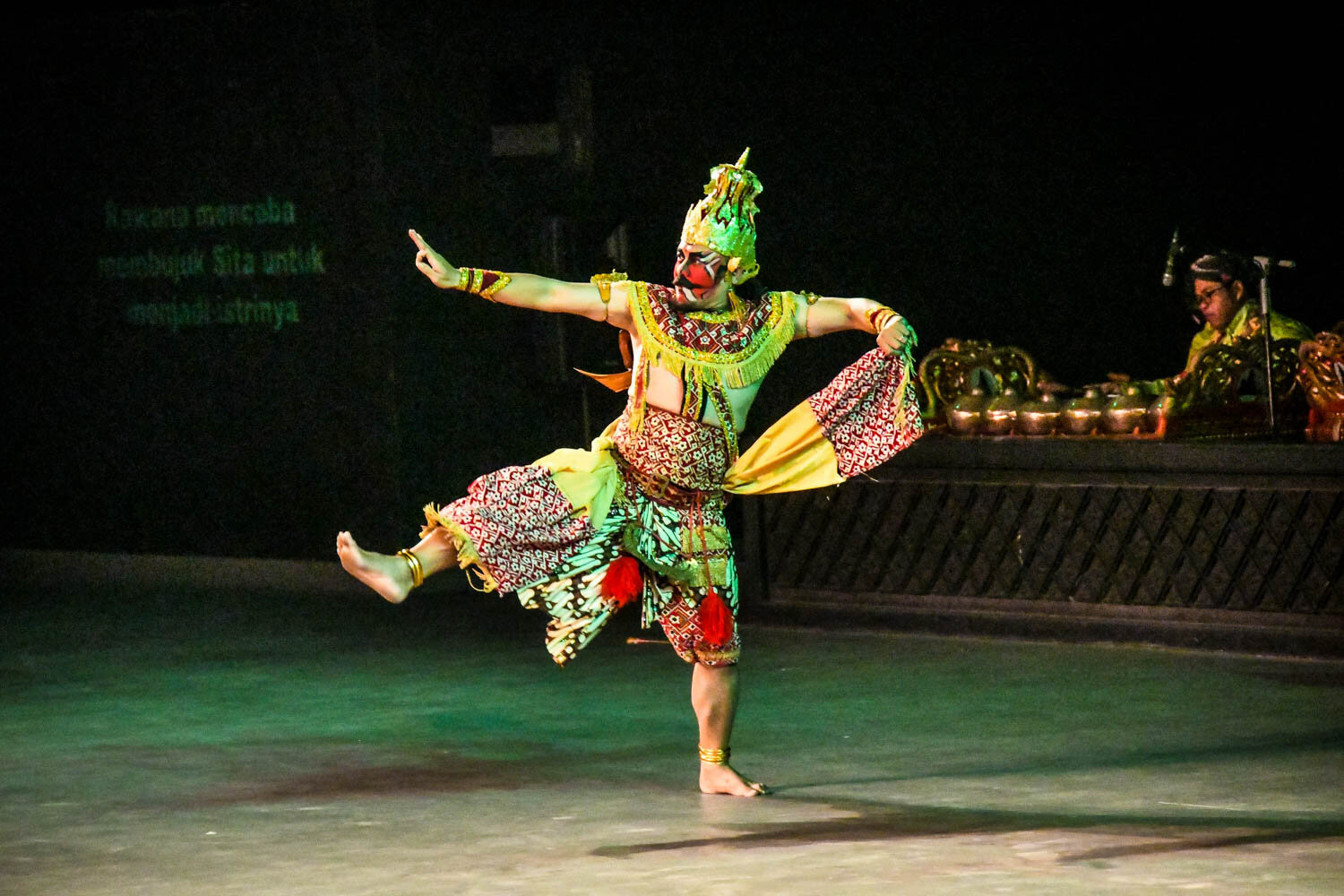

When: Performances take place on Tuesdays, Thursdays and Saturdays
Time: 7:30 p.m. to 9:30 p.m.
Where: During the dry season, this performance is held on an outdoor stage on the Prambanan Temple grounds. During the rainy season (November – April), this performance is held at an indoor stage.
Cost: Tickets range in price:
-
2nd Class: 150,000 IDR
-
1st Class: 200,000 IDR
-
Special: 300,000 IDR
-
VIP: 450,000 IDR
We got the cheapest tickets available (2nd class) and thought they were just fine. The VIP tickets are more than double what the “second class” seats cost, and in our opinion would not have been worth the extra money.
Booking your tickets to the Ramaya Ballet
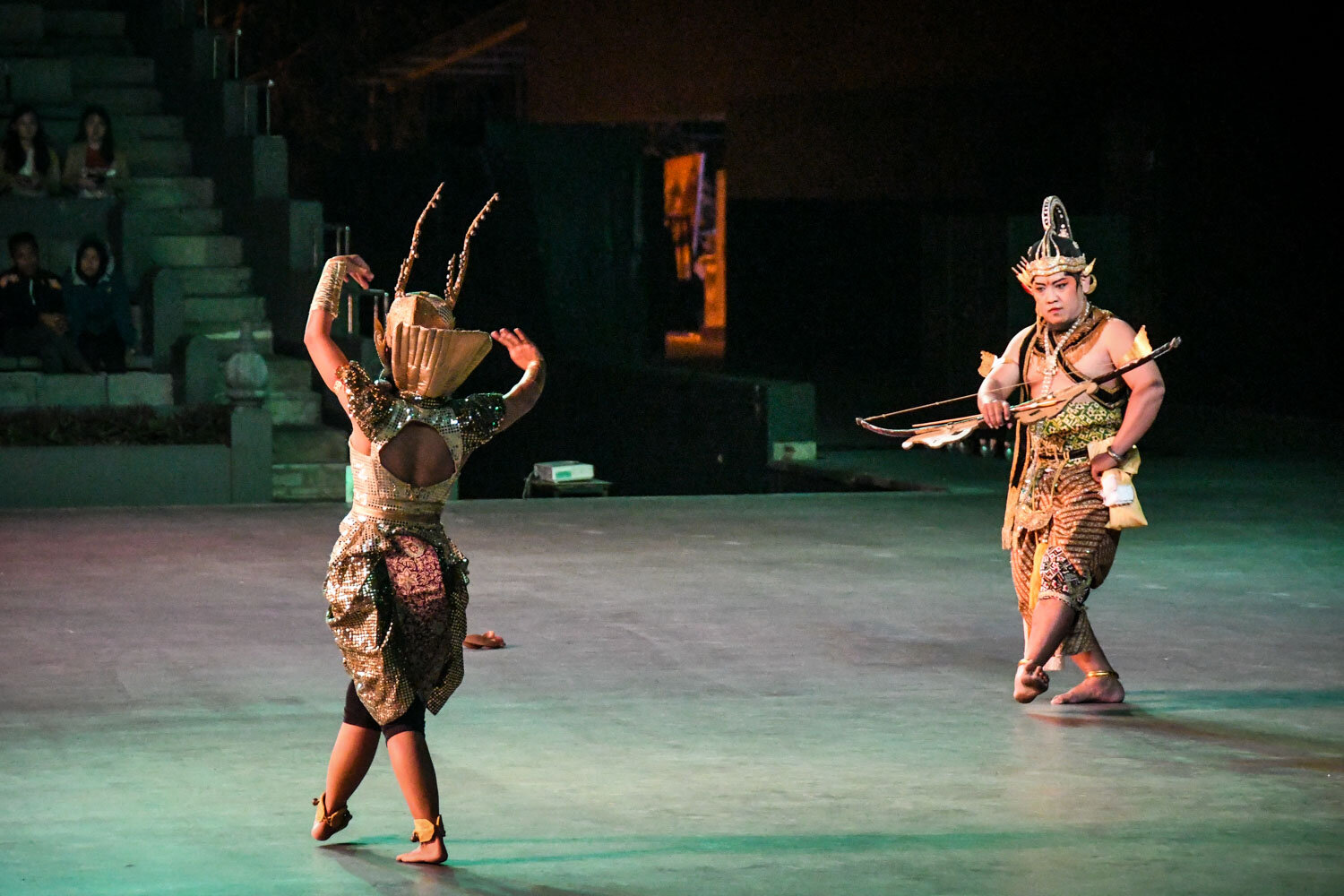

We booked our tickets ahead of time through our hotel since we had no idea what to expect. Let’s just say that it was far from sold out, so we’d imagine you wouldn’t have a problem getting tickets onsite. Plus, the ticket counter had a very difficult time finding our reservation (even though we had a receipt as proof we had already paid).
Buffet Dinner: Combined with the show, you can purchase a buffet dinner, which looked pretty decent. However, get there somewhat early, because by the time we saw the buffet it looked pretty picked over.
Alternatively, you can head to a nearby warung for a cheap local meal. We chose the latter option and were very happy with our choice!
Visiting both Borobudur AND Prambanan
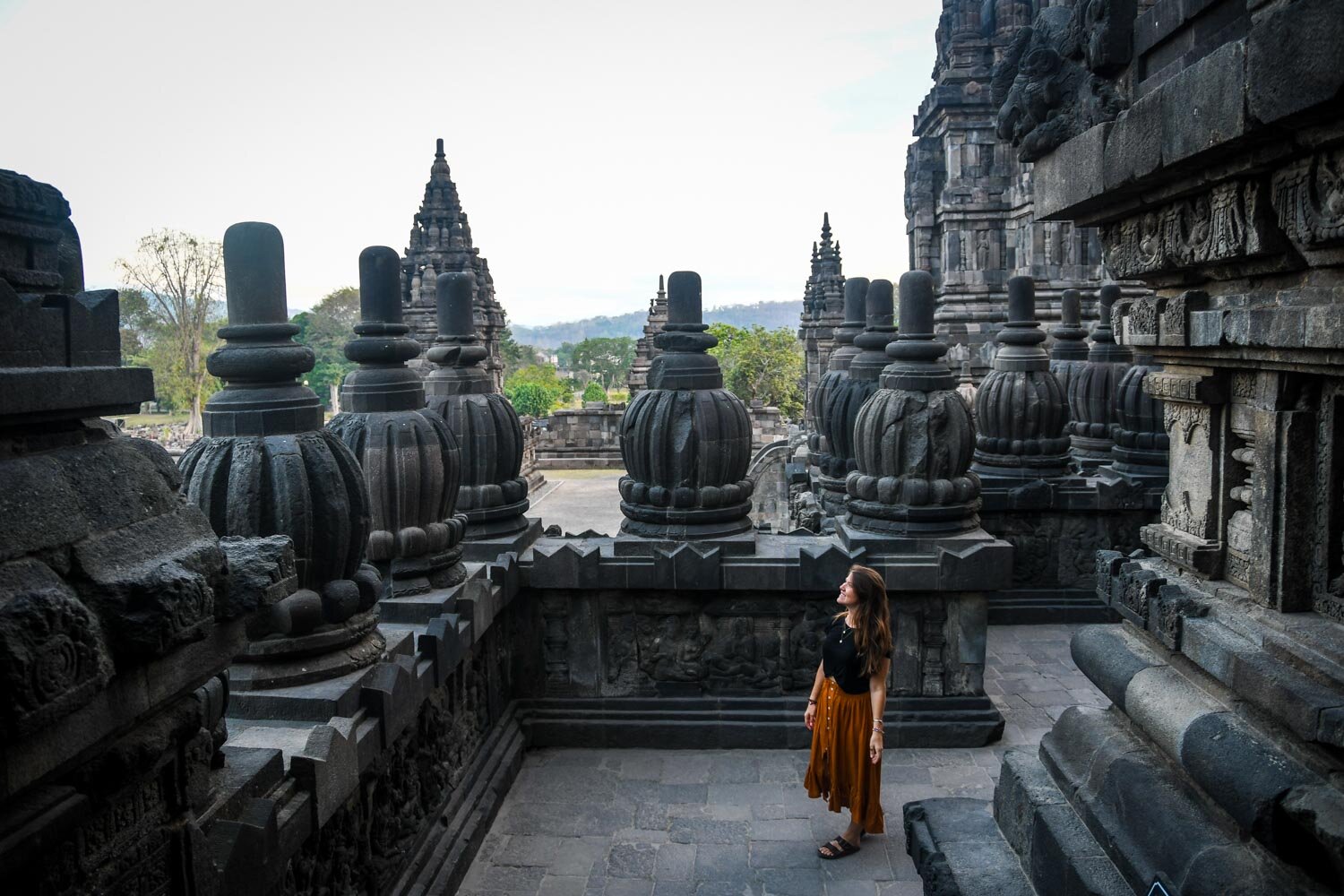

If you’re planning to visit both Borobudur and Prambanan, the following tips are for you!
Is it possible to visit Borobudur and Prambanan in 1 day?
Absolutely! It will be an action-packed day, but it’s possible to pack them both in if you have limited time in Yogyakarta (as long as you don’t think you’ll get “templed out” — something that often happens to us!).
Here’s how we’d recommend visiting both temples in just one day:
-
Morning: Visit Borobudur Temple (either plan to arrive for sunrise, or as soon after as possible)
-
Late morning: return to Yogyakarta, have lunch, relax in your hotel pool (and escape that midday heat!)
-
Afternoon: Head to Prambanan Temple and plan to stay through sunset
-
Evening (optional): If you’re interested in seeing the Ramayana “ballet”, you can stay on the temple grounds and have dinner before the dance starts at 7:30 p.m.
If you’d prefer to have a more chilled day or see each temple at sunrise, you can split up your visit into 2 consecutive days instead (this is what we chose to do).
Borobudur + Prambanan Discount Combo Ticket
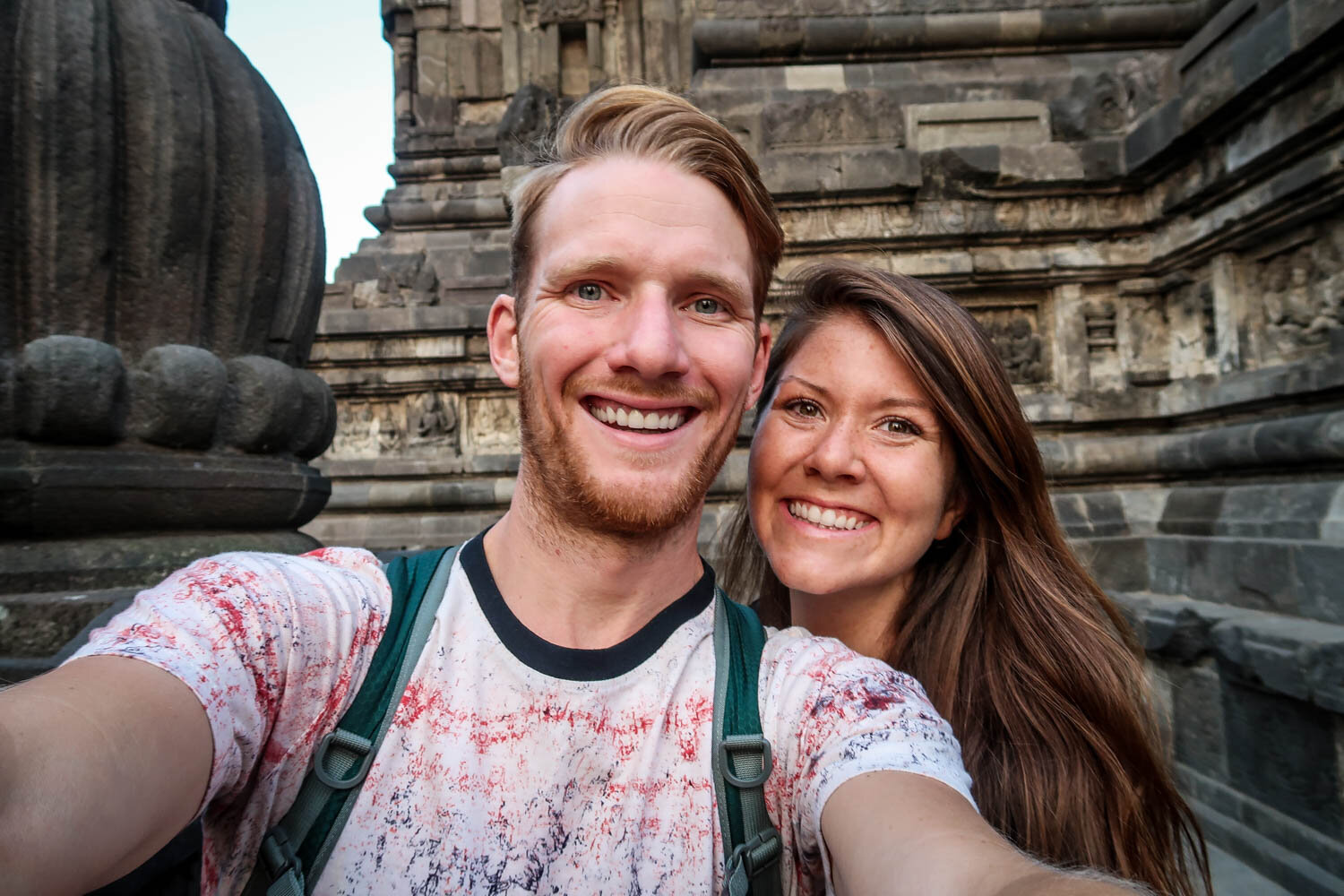

If you plan to visit both Borobudur AND Prambanan (you should!), there is a combined ticket which grants you access to both temples and saves you $5 per adult and $3 per student/child.
Ticket prices for Borobudur Temple were recently increased at the beginning of 2020 (and they seem to increase each year).
Combo Ticket to BOTH Borobudur + Prambanan Temples
-
$45 USD adult (715,000 IDR)
-
$27 student (430,000 IDR)
-
$27 child (430,000 IDR)
The only drawbacks are:
-
This will not apply if you plan to visit either temple at sunrise/sunset, as that is a separate, more expensive price.
-
You must visit both temples within 48 hours, which is just fine for most travelers in Yogyakarta. In fact, it is totally possible to visit both in one day. That’s what we did, as explained above!
What to wear to Borobudur and Prambanan
Be sure your shoulders and knees are covered. This rule applies to both men and women. If you don’t have the correct clothing, you will be given a (surprisingly nice) sarong free of charge to borrow during your visit.
-
For women: I was very comfortable in a maxi skirt and a t-shirt. This combo is breezy and comfortable even on a hot day.
-
For men: A t-shirt and a pair of long shorts (that go just past your knee) or a lightweight pair of pants will suffice. We’d recommend short sleeves on most days since it tends to get quite hot on the temple grounds.
What else is there to do in Yogyakarta?
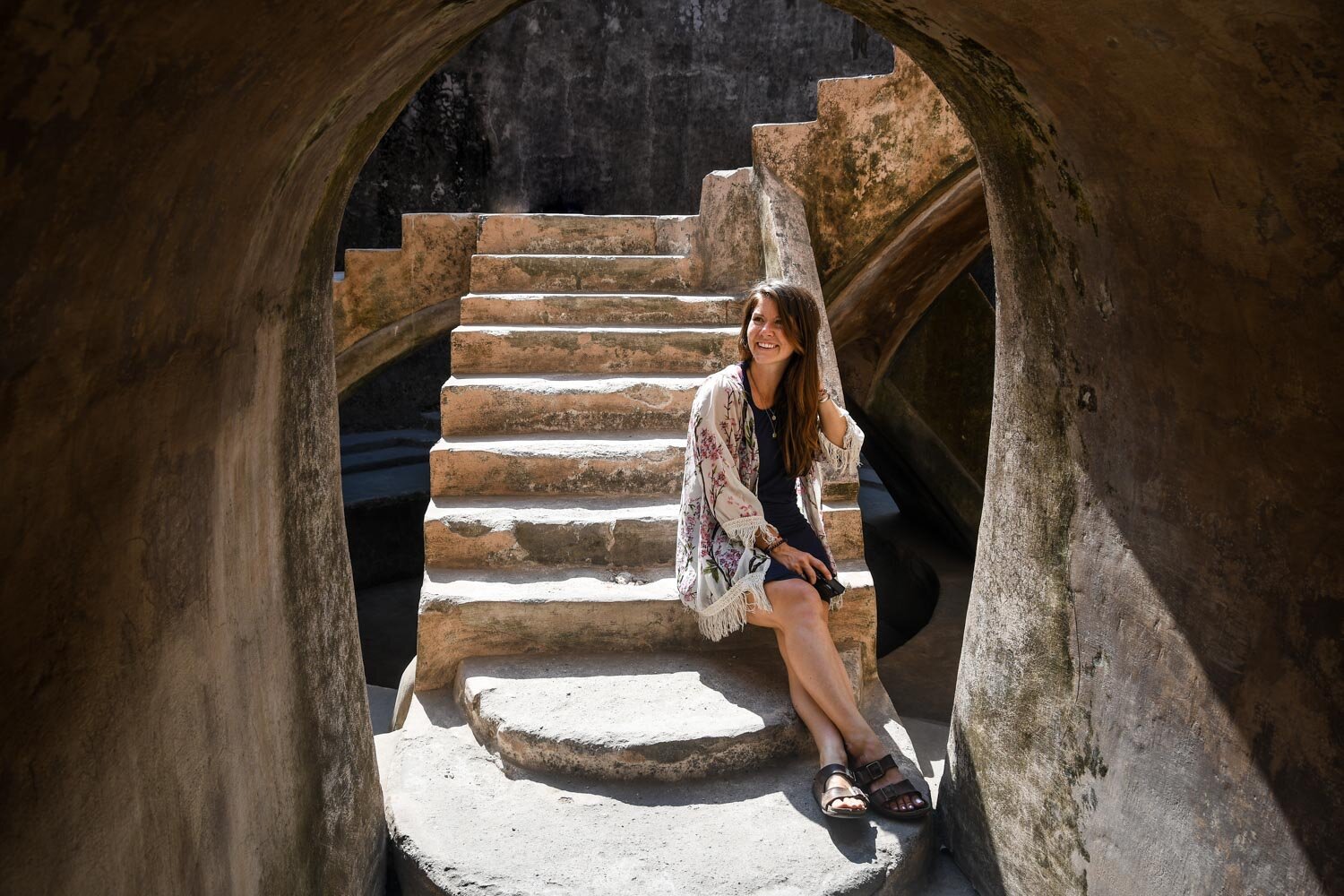

Glad you asked! There’s actually a ton of things to do in this super cool city, and we’d recommend spending a minimum of 2 days there (ideally, 3 – 4 days!).
Here are a few fun things to do in Yogyakarta:
-
Scope out the city’s street art scene.
-
Explore a historic underground Mosque.
-
Go on a street food tour with a local.
-
Go on a caving adventure at Jomblang Cave.
For more tips and (many more!) things to do, we’ve gotcha covered with a huge info-packed guide to Yogyakarta.
You may also like…
We have TONS more resources on Java, so if you’re planning an Indonesia trip, you’ll definitely want to check out our other articles too!
-
Tumpak Sewu Waterfall: Essential Guide to Java’s Best Waterfall
-
Visiting Malang’s Colorful Rainbow Village: Kampung Warna Warni Jodipan
-
Mount Bromo Tour: Sunrise at Indonesia’s Most Famous Volcano
Save this article on Pinterest for later!




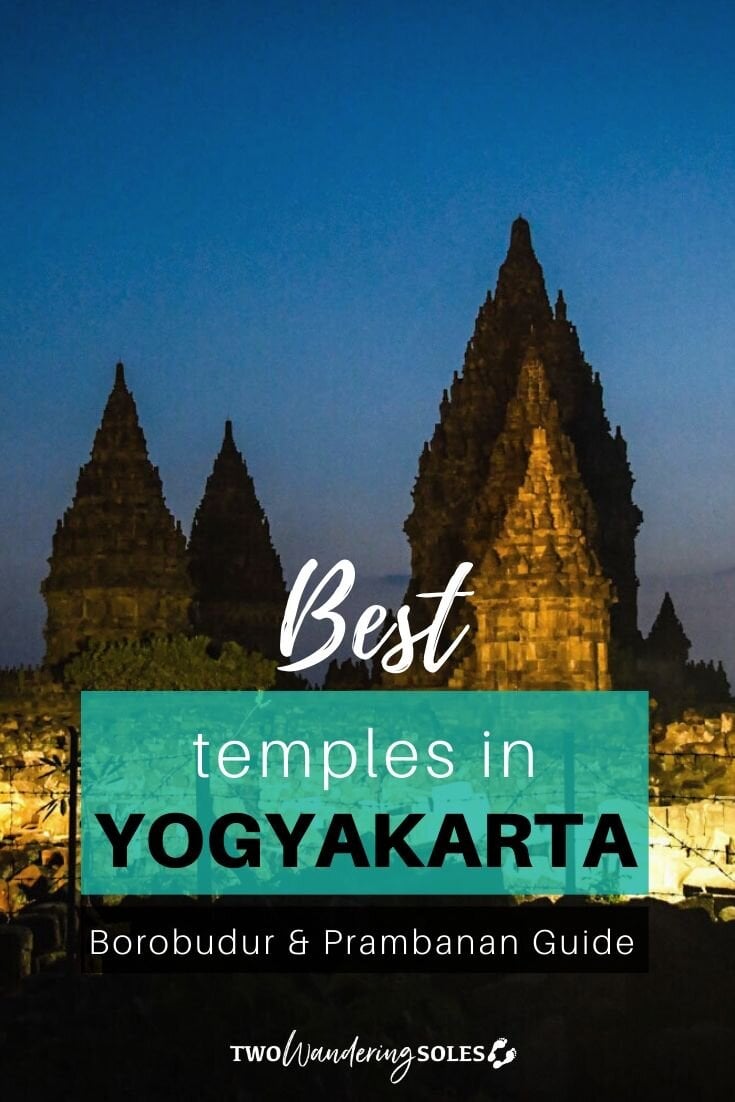



We want to hear from you!
Still have questions about visiting Borobudur and Prambanan Temples? Comment below and we’ll do our best to help!

It was perfect the first time. I learn so much from you as well! Keep it up great post.
Happy you enjoyed it! Thanks 🙂